Chiang Mai is a city where the old and the new flow together—temples and teakwood houses framed by mountains, street food markets alive with color, and a nomad scene that makes it one of the easiest places in the world to land. In a single week, you can move between jungle hikes, cafés, late-night jazz bars, and coworking spaces buzzing with energy.
For digital nomads, Chiang Mai has long been a hub. Affordable, convenient, and endlessly creative, it’s the kind of place where you instantly meet others on the same path, and where daily life feels smooth enough to let you focus on work while still soaking up Thailand’s culture.
In this complete guide, we’ll share everything you need to know about living, working, and exploring in Chiang Mai: where to stay, the best coworking and coliving spaces, the vegan food scene, and what to do when you’re off the clock.
Why Chiang Mai?
Chiang Mai is the kind of city where life feels both effortless and textured. You can start your day with a fresh coconut at a street stall, bike past golden temples shimmering in the morning light, and end it tucked into a jazz bar or night market, surrounded by a mix of locals, travelers, and fellow nomads. The mountains press close, the air smells faintly of incense and grilled lemongrass, and the pace is calm without ever feeling sleepy.
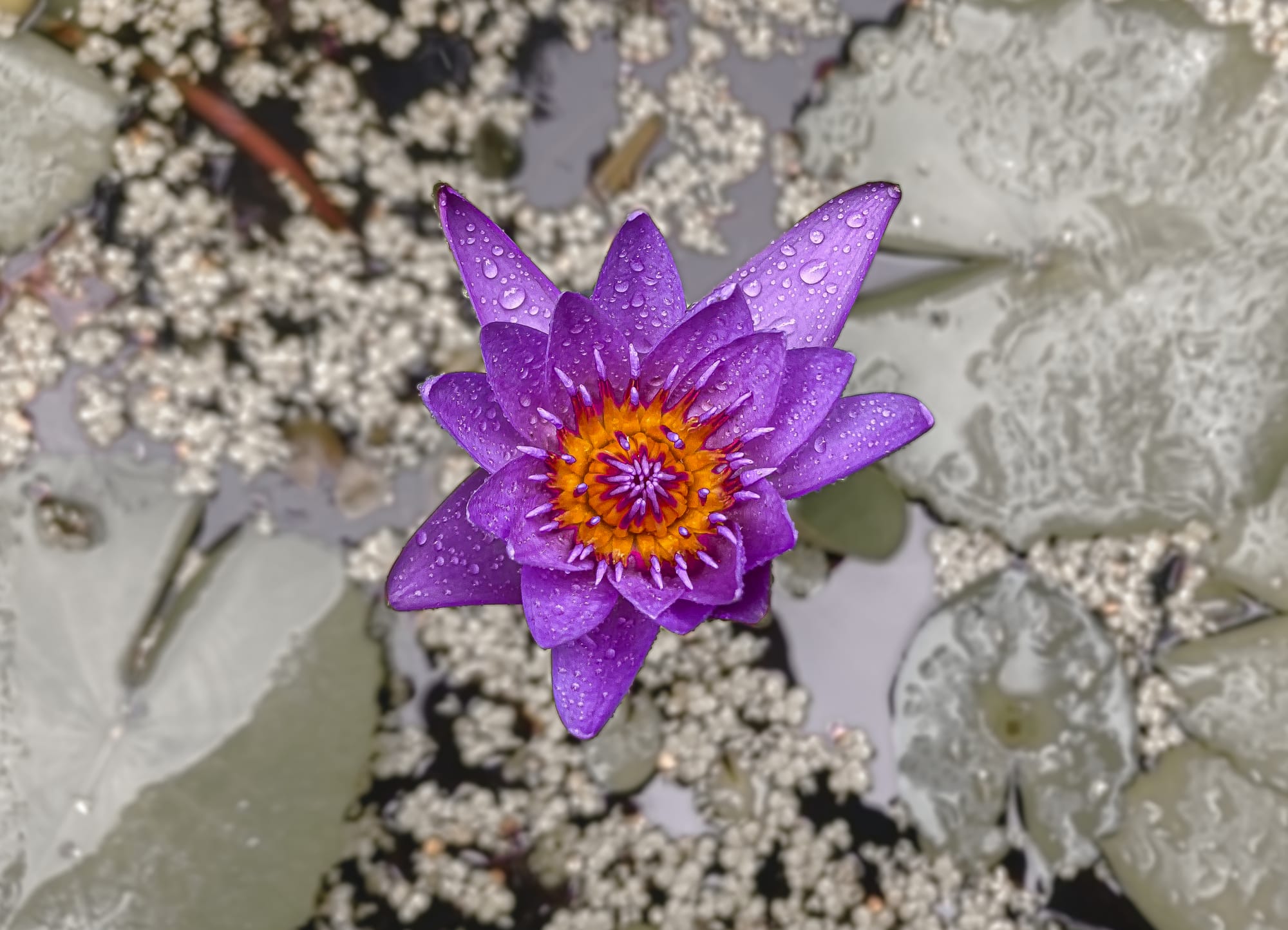
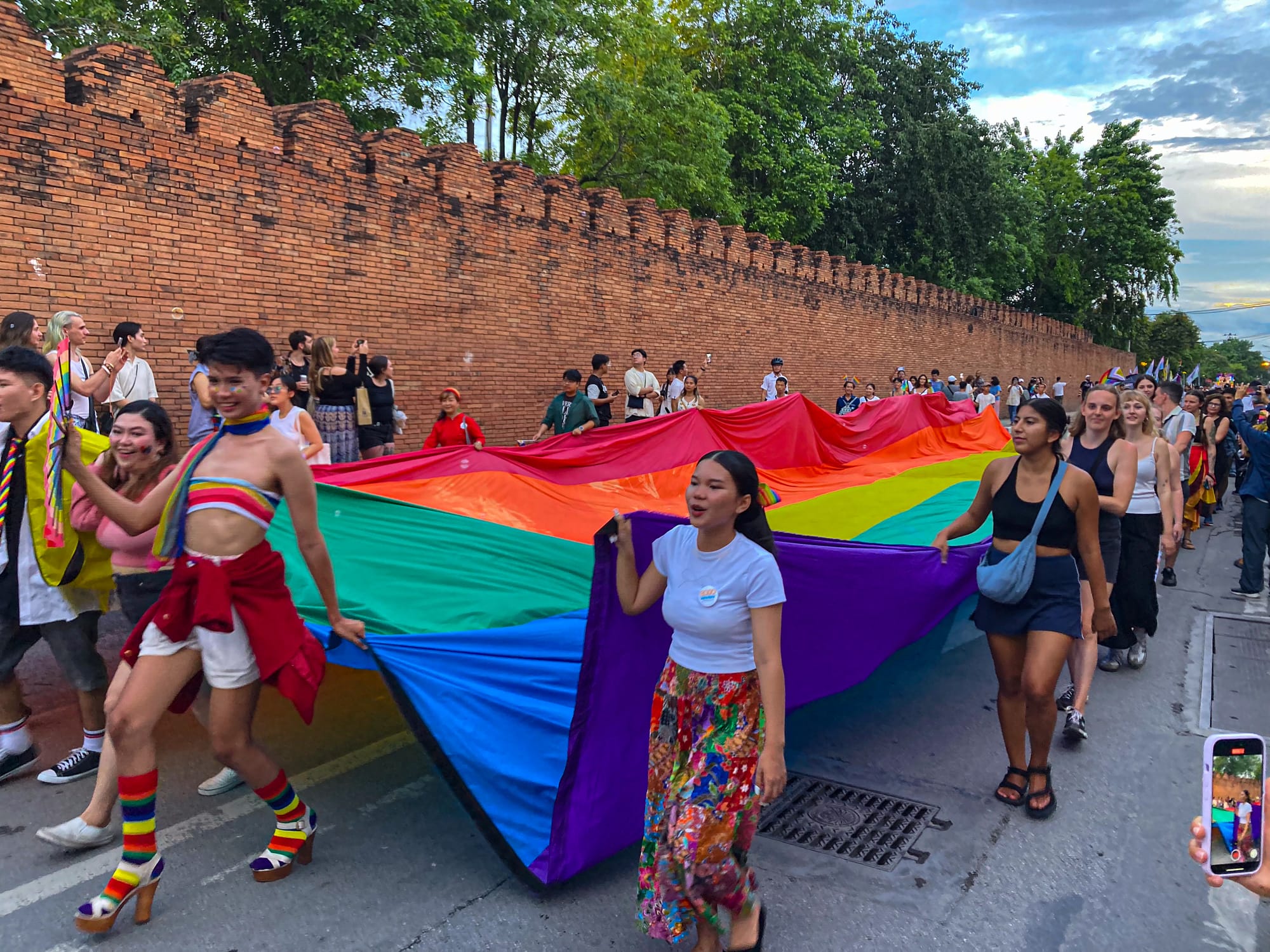
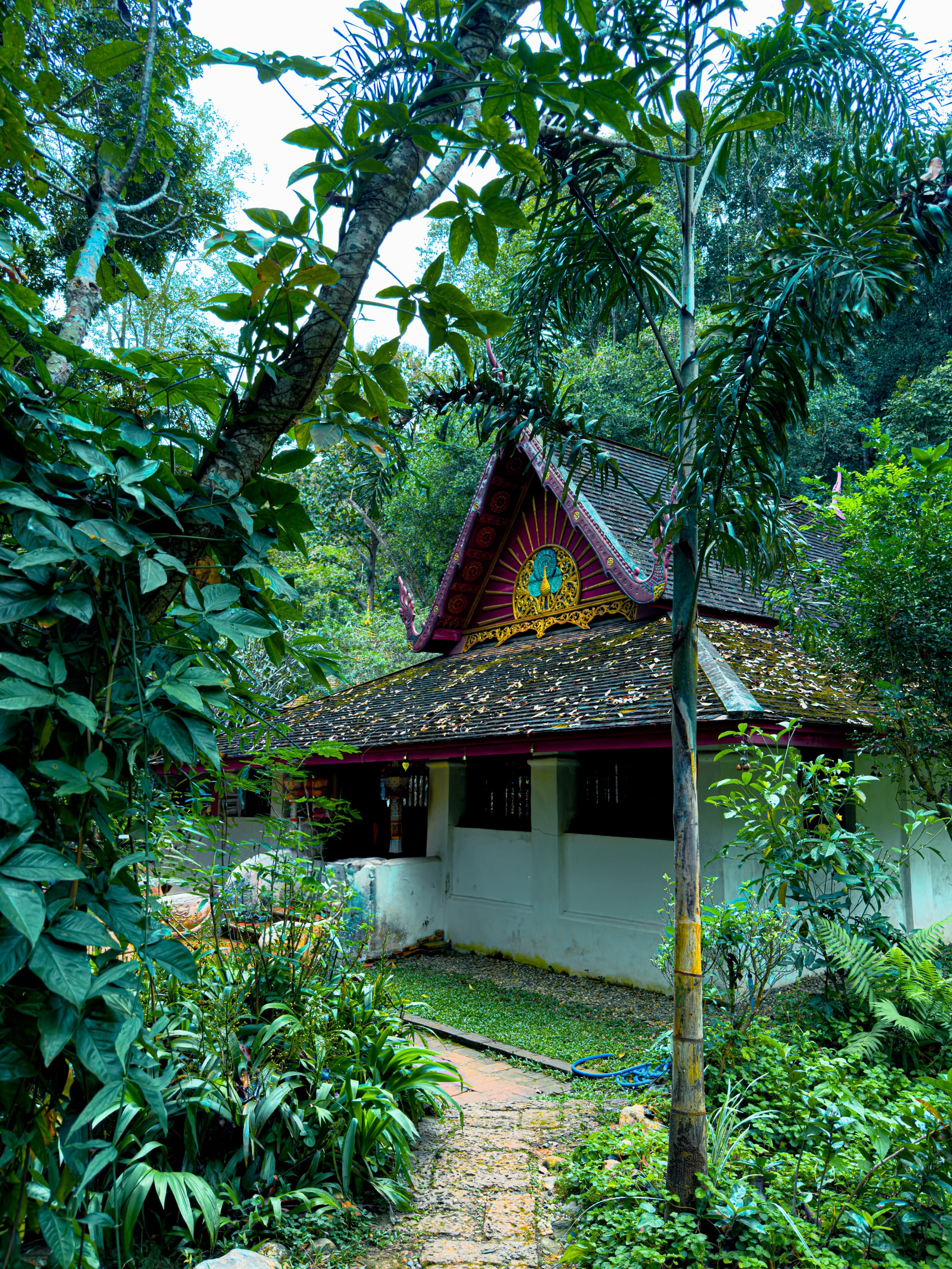
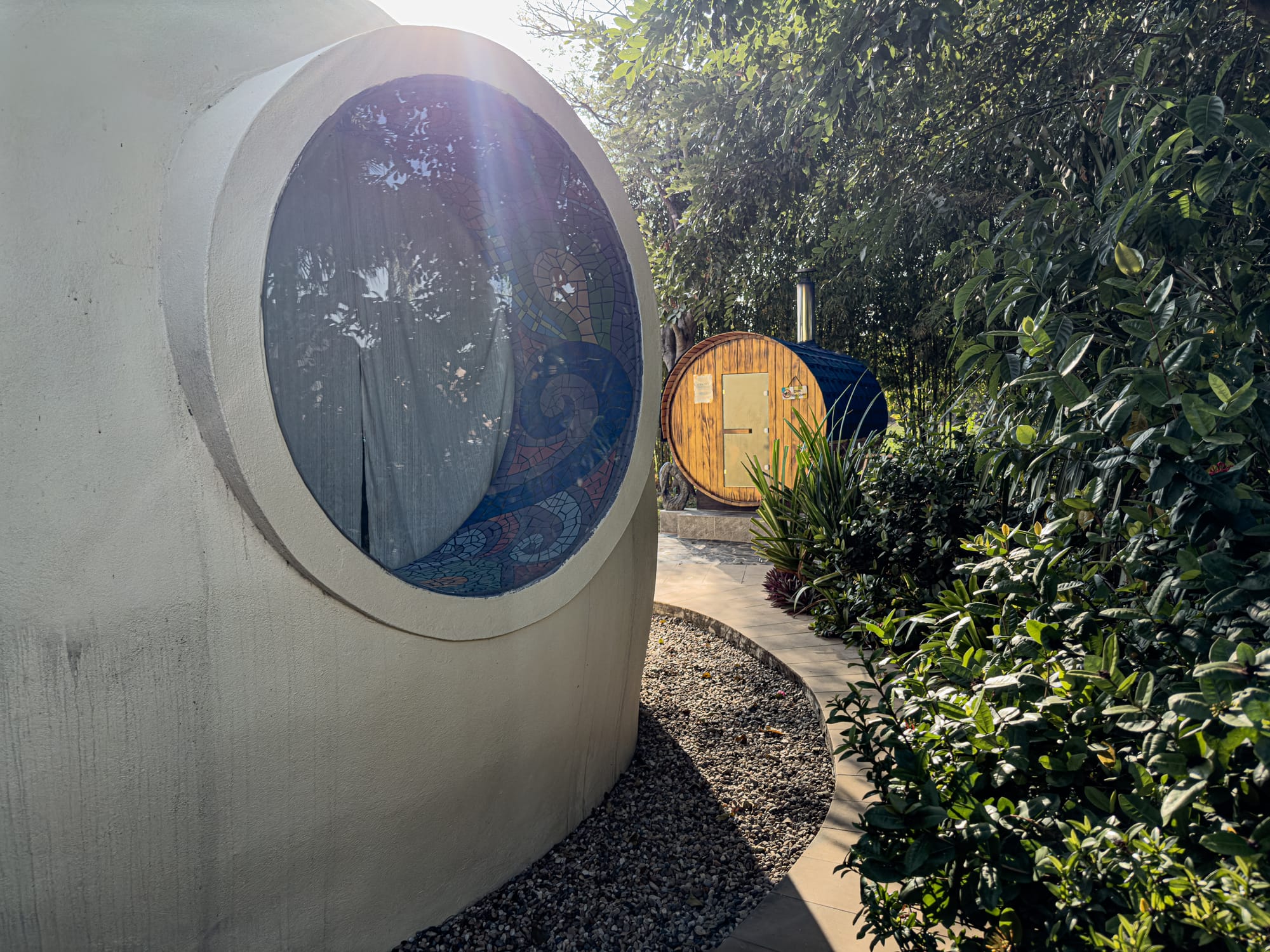
What sets Chiang Mai apart from other nomad hubs isn’t just cost or convenience—it’s balance. You’re never far from something grounding. Spend a morning hiking in the forests of Mae Rim, or wandering temple courtyards where saffron-robed monks sweep the leaves. Then come back into town, open your laptop in a café, and join a table of other remote workers who’ve folded into the same rhythm. The natural world and city life don’t compete here—they weave together.
Unlike Bangkok or other bigger Southeast Asian cities, Chiang Mai hasn’t been overrun by glass towers and urban noise. It’s a mid-sized city with the infrastructure that nomads need—fast wifi, abundant cafés, coworking and coliving spaces—layered over centuries of culture, craft, and tradition. You’ll find night bazaars, fresh markets, plant-based restaurants, and neighborhood lanes where life still moves at a village pace.
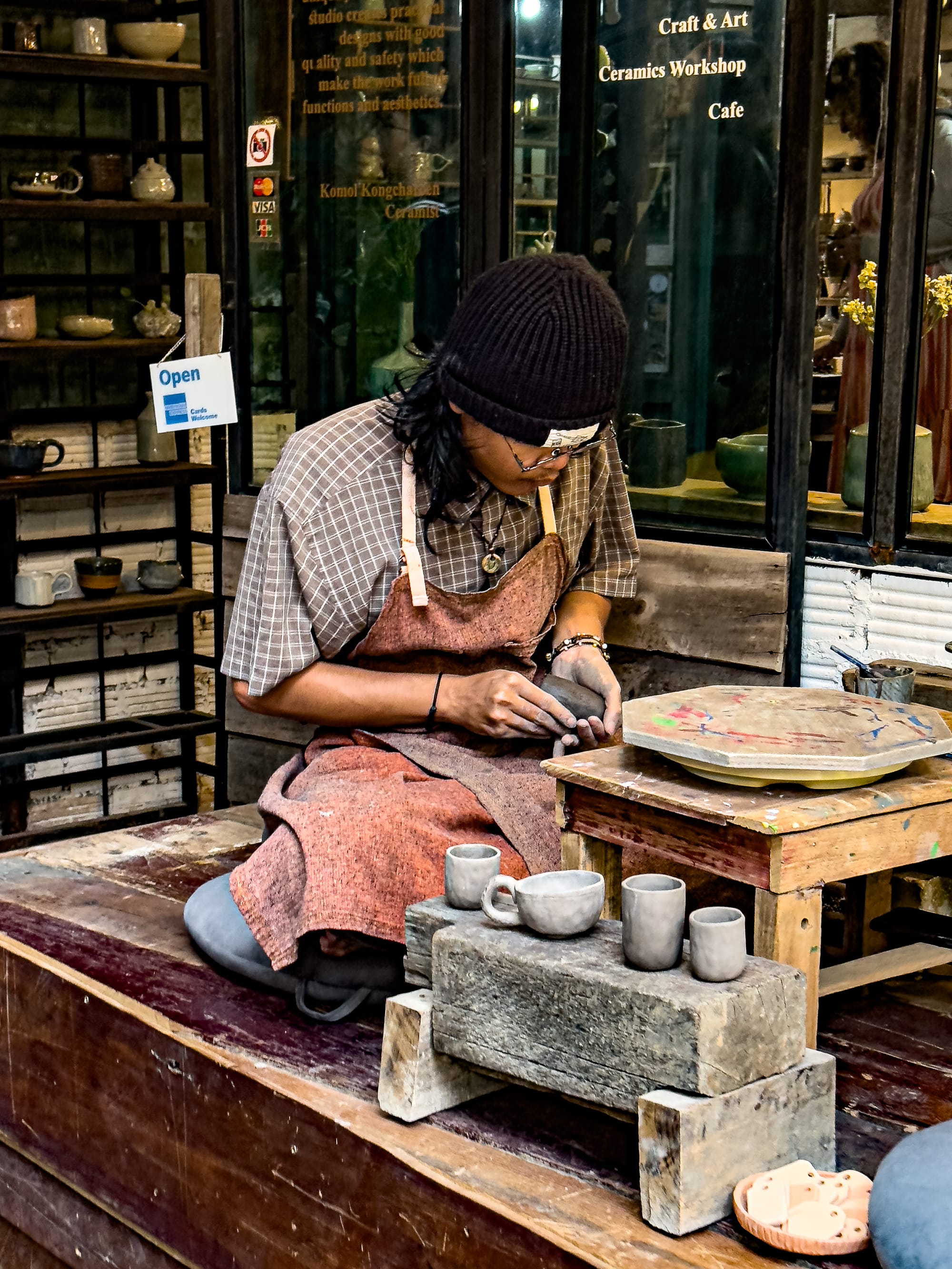
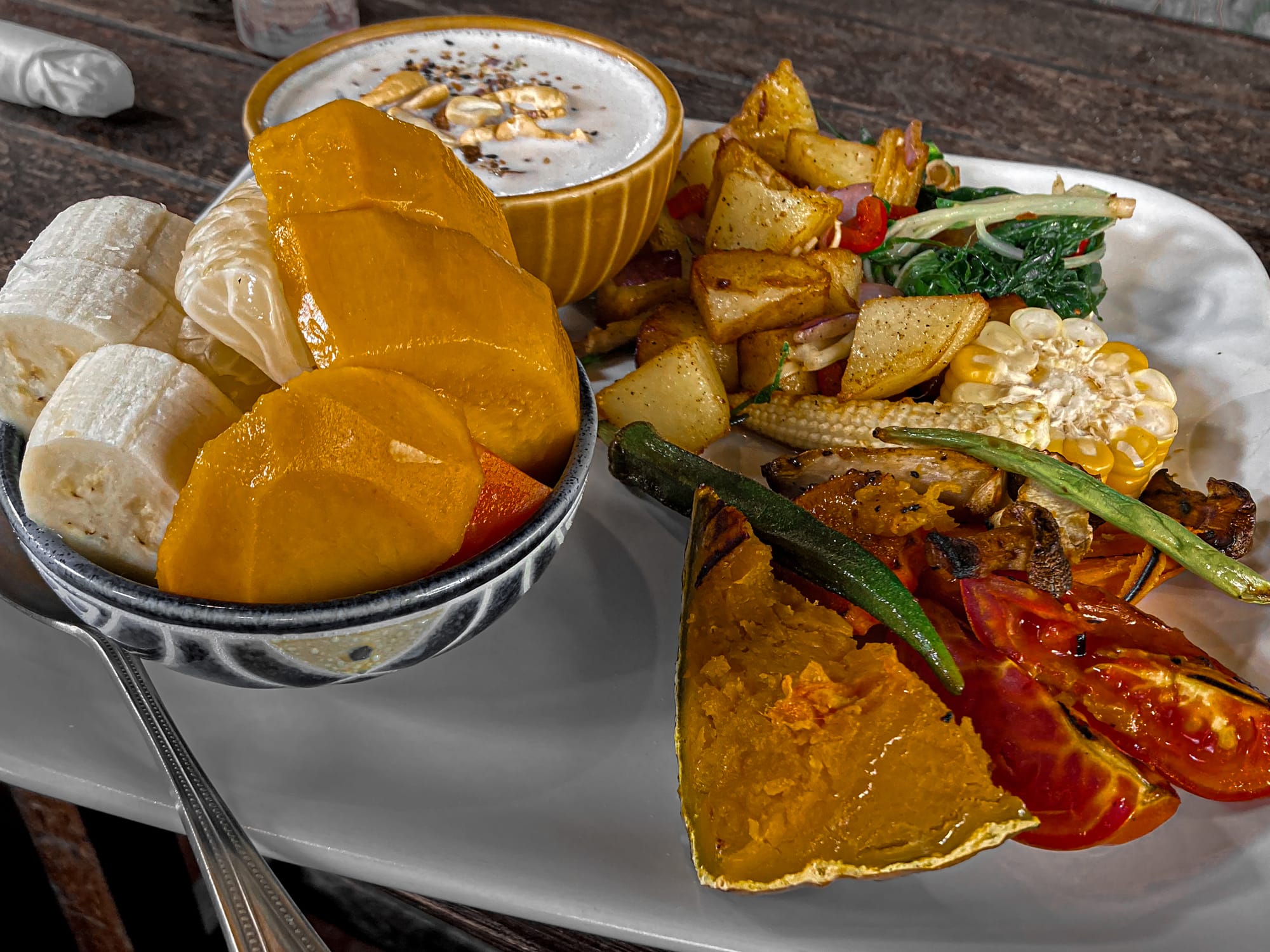
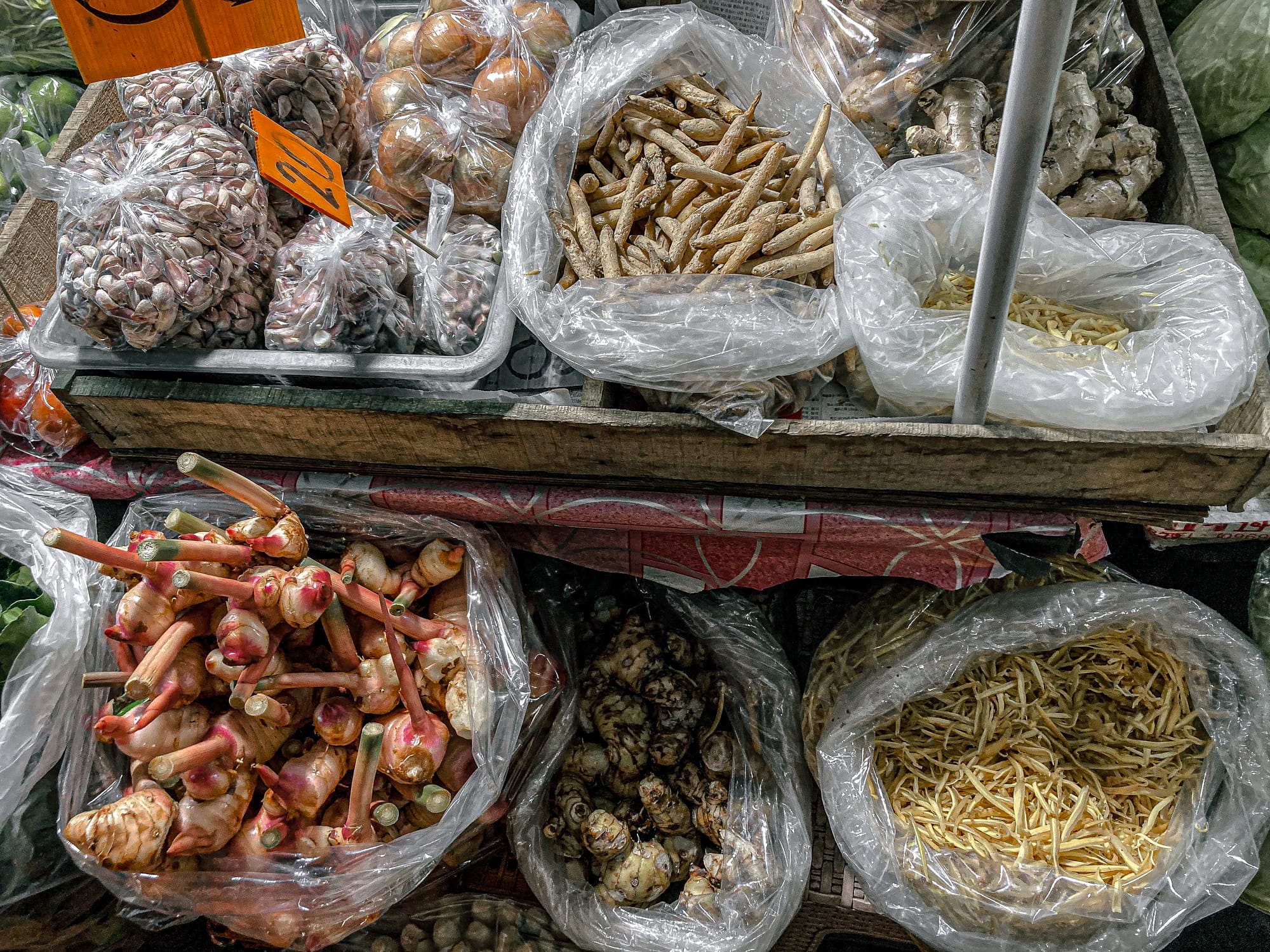
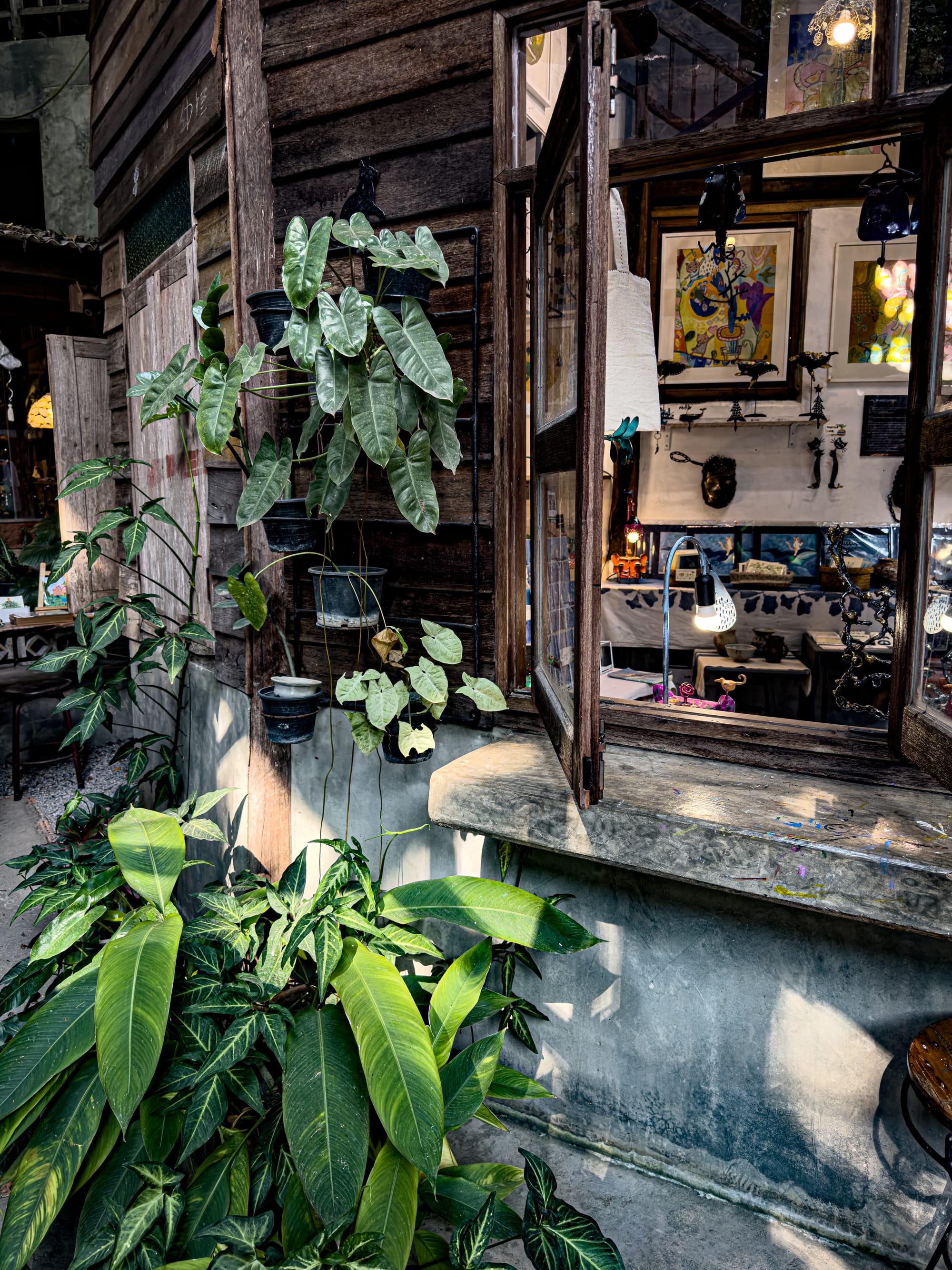
For digital nomads, the community here is legendary. This is one of the original hubs where the idea of “working anywhere” took root, and the network remains strong. Whether you drop into a coworking space like Yellow, or a coliving like The Social Club or Alt_ChiangMai, you’ll instantly find yourself surrounded by others living a similar lifestyle. Connections happen quickly, collaborations even faster.
The timezone also works in your favor if you’re working with Europe or the US. Mornings stretch wide open for exercise, meditation, or slow breakfasts, and by the time you’re ready to dive into work, the rest of the world is online. Evenings spill naturally into shared meals, yoga classes, or a scooter ride up Doi Suthep for sunset.
The city of temples
In Chiang Mai, temples aren’t tucked away behind gates or reserved for special visits—they’re everywhere. Golden stupas rise from neighborhood backstreets, saffron-robed monks sweep leaves in shaded courtyards, and incense curls into the morning air as you pass by on your way to a café. With over 300 temples across the city, the sacred isn’t hidden. It’s ambient.
Unlike Bangkok’s monumental complexes, Chiang Mai’s temples are woven into daily rhythm. You might walk past Wat Phra Singh on your way to the market, hear chanting float from Wat Chedi Luang while riding your scooter home, or stumble into a quiet neighborhood wat where locals light candles at dusk.
Step inside and the atmosphere shifts. Gold leaf glimmers against dark teak wood, lotus flowers rest in offering bowls, and murals tell centuries-old stories in colors that still pulse with detail. Some temples host meditation sessions open to visitors. Others run community kitchens or schools. Even the smallest shrines feel active, tied to the rhythms of prayer, teaching, and care.
For nomads, this closeness to the sacred adds a texture that’s hard to replicate elsewhere. Your workdays unfold in a city where time is measured not just by calls and deadlines, but by bells ringing from temple towers. You can pause for a moment of stillness in a courtyard, or simply notice the quiet hum of devotion that pulses through the city.
Temples in Chiang Mai don’t just tell the story of the past—they shape the present. They anchor neighborhoods, set a tone of calm, and remind you that life here is held together by more than convenience. It’s a reminder, woven into the city itself, that there’s always space for pause, reflection, and reverence.
When to go
The best months to visit Chiang Mai are November through February, with December and January being especially pleasant. The skies are clear, the air is cooler, and the days hover around 25°C—ideal for temple walks, coworking, and weekend trips into the surrounding mountains. This stretch also coincides with major festivals like Loy Krathong and Yi Peng, when thousands of lanterns light up the night sky.
March through April is when burning season arrives. Farmers across Northern Thailand burn agricultural fields to clear stubble, and the result is thick smoke that settles into the valley around Chiang Mai. Air quality drops dramatically, with some days hitting hazardous levels. Many nomads avoid this period entirely, choosing to relocate to other parts of Thailand or Southeast Asia.
May through August brings the hottest weather. April in particular is infamous for extreme heat, often soaring past 35°C. Daily life slows, outdoor exploring becomes uncomfortable, and without good air conditioning it can be draining. By late May the rainy season starts, which cools things slightly but also brings daily downpours. The landscape turns lush and green again, and rice fields come alive, but the humidity can be intense.
September and October are transitional months. Rain is still common, but skies begin to clear, and the countryside glows with harvest colors. It’s less crowded, and the cooler evenings hint at the comfortable season just around the corner. If you don’t mind occasional storms, it’s a peaceful time to settle in before the high season begins.
Our advice on the best time to be in Chiang Mai
If you’re coming for a longer nomad stay, November–February is the clear winner. The weather is cool, the air is clean, and festivals make the city feel vibrant and alive.
If you want to experience Chiang Mai in its greenest form, late August–October is a rewarding shoulder season. You’ll deal with some rain, but the rice fields and waterfalls are at their best, and prices are lower.
If you’re sensitive to heat or air quality, avoid March–April. Burning season and soaring temperatures combine to make it the least comfortable and least healthy stretch of the year.
For a mix of culture, climate, and connection, the end of the year—November through January—gives you the fullest Chiang Mai experience: lantern festivals, cool mornings, and the city at its most inviting.
Getting to and from Chiang Mai
Chiang Mai International Airport (CNX) sits just 15 minutes from the Old City, making arrivals unusually smooth compared to other nomad hubs. Direct flights connect Chiang Mai to Bangkok, Phuket, Koh Samui, and most major Thai cities, as well as international routes across Asia—common hubs include Singapore, Kuala Lumpur, Hong Kong, Taipei, and Seoul.
For most travelers coming from Europe or North America, flights typically route through Bangkok (BKK or DMK). From there, it’s an easy one-hour hop north, with dozens of flights daily. Trains and overnight buses also link Bangkok and Chiang Mai, but for many nomads, the quick domestic flight wins on both price and convenience.
If you’re slow traveling through Southeast Asia, Chiang Mai pairs well with other nomad favorites. A common rhythm is to base in Chiang Mai for November and December, then move south to Koh Lanta in January and February for island life, before continuing east to Hội An in March. From Chiang Mai, it’s easy to connect into this arc: flights to Krabi for Koh Lanta are frequent, and Da Nang for Hội An is just a short connection away via Bangkok.
Chiang Mai also links easily with broader circuits. Many nomads use it as their northern hub before hopping out to Bali, Kuala Lumpur, or Taipei, or even heading west toward Europe via long-haul connections out of Bangkok.
Working remotely from Chiang Mai
Chiang Mai is one of the most established digital nomad hubs in the world, and you feel it as soon as you open your laptop. There are dozens of coworking spaces spread across the city—from big, structured setups to smaller, community-oriented spaces. Many coliving spaces also double as coworking hubs, so you can live and work under the same roof with other nomads.
Beyond formal coworking, Chiang Mai has an incredibly strong café-working culture. Practically every neighborhood has a scattering of laptop-friendly cafés, complete with strong wifi, good coffee, and reliable outlets. From leafy garden cafés to sleek, air-conditioned spots in Nimmanhaemin, you’ll never run out of new places to work. For many nomads, café-hopping is as much a part of the rhythm here as coworking itself.
Coliving is another major draw. Spaces like Alt_ChiangMai, Alt_PingRiver, and The Social Club make it easy to plug into an instant community while keeping work central to your stay. The choice is wide: some offer daily social events, while others keep things quieter for those who want focus above all else.
In short, there’s no shortage of options. Whether you prefer a structured coworking space, the ambient buzz of a café, or the all-in-one setup of coliving, Chiang Mai has more than enough to keep you productive and connected.
Digital nomad community
Chiang Mai’s digital nomad community is one of the largest and most established in the world. At any given moment, thousands of remote workers are based here—some for a few months, others returning year after year. Unlike smaller hubs where everyone gravitates toward the same coworking space or weekly meetup, Chiang Mai’s scene is so big and diverse that you can almost choose your own sub-community and dive in.
For some, that means joining one of the many coliving spaces like The Social Club or Alt_ChiangMai, where community is built into daily life through shared meals and group events. For others, it’s about hanging out in Nimmanhaemin cafés, meeting fellow laptop workers over flat whites, or dropping into one of the city’s dozens of coworking spaces. There are also plenty of hobby-based groups—yoga, climbing, language exchanges, board games, bachata—so you can connect with people beyond the work context.
Because the scene is so large, it’s also highly international. You’ll meet seasoned nomads who’ve been coming here since the early 2010s, alongside people on their very first remote-work trip. And while it’s not unusual for expats and nomads to overlap in other cities, in Chiang Mai those boundaries are especially porous: you might go from a coding session at a coworking space to dinner with a long-term local friend in the same day.
The sheer size can feel overwhelming if you’re new, but the upside is that you’ll always find people who share your rhythm—whether that’s late-night jazz at North Gate, early-morning meditation at a temple, or quiet dinners after long days of focused work. Chiang Mai isn’t a one-size-fits-all community; it’s a whole constellation of them.
Chiang Mai's culture
Chiang Mai’s culture is inseparable from its roots as the capital of the Lanna Kingdom. The city still carries the imprint of that heritage in its moats and walls, its hundreds of temples, and the daily rhythms of life that blend tradition and modernity. Step into the Old City and you’ll see saffron-robed monks collecting alms at dawn, incense curling through temple courtyards, and locals stopping to wai in quiet respect. These rituals shape the spiritual pulse of the city.
Food is central to Chiang Mai’s culture. Morning markets brim with herbs, spices, and vegetables from the surrounding hills, while street stalls sell khao soi, sticky rice, and fruit shakes well into the night. Family recipes and regional specialties are passed down through generations, blending influences from Burma, China, and Laos with northern Thai roots. For those living here longer, this rhythm of markets and meals quickly becomes part of everyday life.
Festivals are another defining feature. Yi Peng and Loy Krathong each November transform the city into a place of fire and light, with lanterns floating into the sky and candle-lit offerings drifting down the Ping River. Songkran, the Thai New Year in April, brings days of water fights and temple ceremonies. Smaller festivals linked to harvests, Buddhist holidays, and hill tribe traditions punctuate the year with color and sound.
Beyond the festivals, Chiang Mai also has a vibrant creative culture. Art studios, craft villages, and community markets like Baan Kang Wat highlight how making—whether ceramics, textiles, or wood carving—is still woven into the fabric of life. Even the café scene carries this energy, with many spaces doubling as galleries, craft shops, or performance venues.
The surrounding hills are home to diverse ethnic groups often collectively referred to as hill tribes, including Hmong, Karen, Akha, and Lahu communities. Their traditions—distinct languages, textiles, agriculture, and spiritual practices—are an important part of the cultural landscape of northern Thailand. While tours of hill tribe villages are commonly marketed, we find it problematic when these experiences treat communities as spectacles rather than as people living complex, modern lives. A more respectful way to engage with hill tribe culture is through cooperatives, markets, and craft collectives where artisans share their work on their own terms. These efforts help sustain traditions without reducing them to tourist displays.
The atmosphere of Chiang Mai is generous and open. Locals are proud of their heritage and often eager to share it, whether through food, festival, or conversation. For nomads, it’s a city where culture isn’t confined to tourist attractions—it’s lived daily, in temples, kitchens, and markets, shaping the cadence of life around you.
Psychogeographics
What does it actually feel like to live in Chiang Mai for a month or more? Think morning walks past golden temples, afternoons where the air hums with café chatter and the scent of roasting coffee, and evenings spent under strings of lanterns at night markets. This is a city where you might start your day meditating at a neighborhood wat, break for a khao soi lunch, and end by listening to live jazz in the Old City.
The mountains are always on the horizon, and they tug at your weekends. Trails wind up through bamboo forests and waterfalls. Mae Rim sits just a short drive away, offering flower fields, botanic gardens, and cool air that feels like escape. The natural world isn’t background—it shapes the cadence of your weeks, giving you reasons to step away from the laptop and out into green.
Workdays take on their own rhythm here. Coworking spaces buzz with digital nomads; cafés open early with plant-based breakfasts and pour-over coffee; afternoons drift easily into dinners with friends or a yoga class at a nearby studio. It’s a city tuned for nomads, but one that still feels deeply Thai—where local life, festivals, and rituals flow around you, grounding the experience.
We wrote a full piece on the texture of life here: Between temples and mountains: digital nomad life in Chiang Mai.
Where to stay
Chiang Mai is full of options—colivings, boutique hotels, and private apartments—so you can choose between built-in community or a quieter, independent stay. Here are our top picks, grouped by neighborhood.
Old City
Alt_ChiangMai Coliving & Coworking: This coliving blends private rooms with an easy, community-first coworking setup. Reliable wifi, shared spaces, and low-key events make it simple to settle in and meet other remote workers, steps from temples, cafés, and the moat.
The Social Club Coliving & Coworking: A community-oriented base that pairs comfortable rooms with a solid coworking space. Expect an events calendar, shared kitchens, and an easy way to plug into a social rhythm without sacrificing focused work time.
Werun Nimbly: Set inside the Old City, Werun Nimbly offers modern, tidy rooms on a quiet street with easy access to temples and the moat. A straightforward, comfortable base if you want to walk everywhere.
The Peaberry Boutique Hotel: The Peaberry pairs Lanna-inspired touches with warm, attentive service. A comfortable, walkable base for exploring the moat area, markets, and nearby coffee spots.
The Old City Rooms: Simple, central rooms in the Old City, and right next door to Old City Spa for effortless sauna and ice bath days. Great if you want a no-frills base with wellness just outside your door.
Nimman
Hub53 Coliving & Coworking: A Chiang Mai favorite close to Nimman’s cafés and coworking culture. Private rooms, steady wifi, and multiple work zones make it a practical, good-value base for short or longer stays.
Cozy Studio in Nimman: A simple, well-located studio in Nimman—clean, compact, and convenient for café-hopping and coworking days. Ideal if you prefer your own space and an independent routine right in the neighborhood.
Ping River
Alt_PingRiver Coliving & Coworking: A calm coliving near the Ping River with bright, modern rooms and an airy work area. It’s a good fit if you want quieter evenings, riverfront walks, and a quick ride into the Old City when you’re ready for cafés and markets.
The best things to do in Chiang Mai
There’s no shortage of things to do in Chiang Mai. What stood out most to us was the atmosphere: quiet forest temples tucked into the hills, long afternoons in cozy cafés, night markets glowing with food and crafts, and weekend getaways into the mountains around Mae Rim.
This list gathers our personal highlights. Many have full posts you can dive into if you want more photos and detail.
Nature escapes near the city
The Monk’s Trail to Wat Pha Lat
A jungle path leading to a hidden forest temple.
Starting just outside Chiang Mai University, the Monk’s Trail winds uphill through quiet forest to Wat Pha Lat, a peaceful temple complex perched above the city. Along the way, the path is shaded by tall trees and punctuated by orange monk robes tied to trunks, marking the spiritual significance of the route. At the top, waterfalls tumble through mossy stone steps and shrines, with views stretching back across the city below.
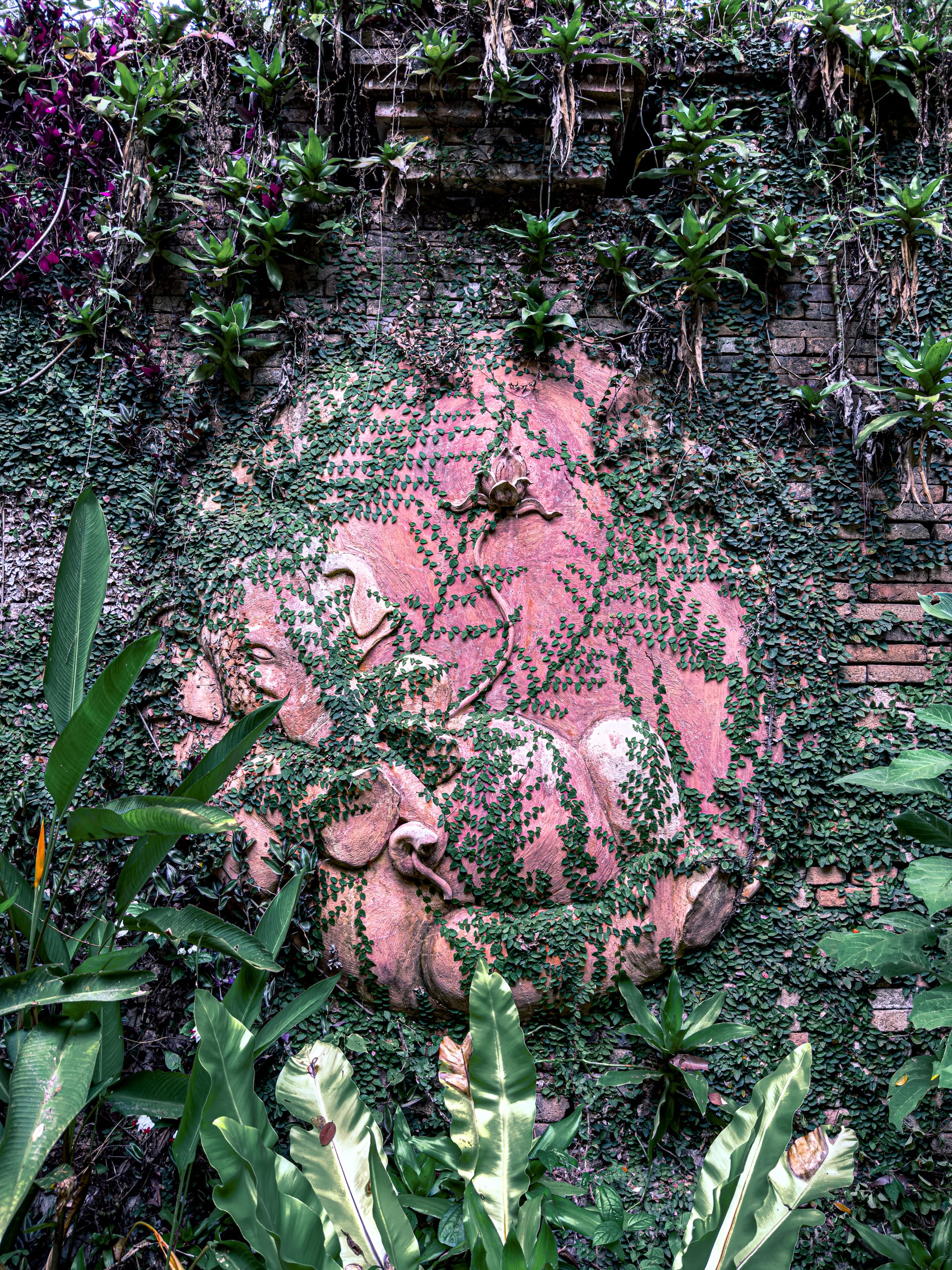
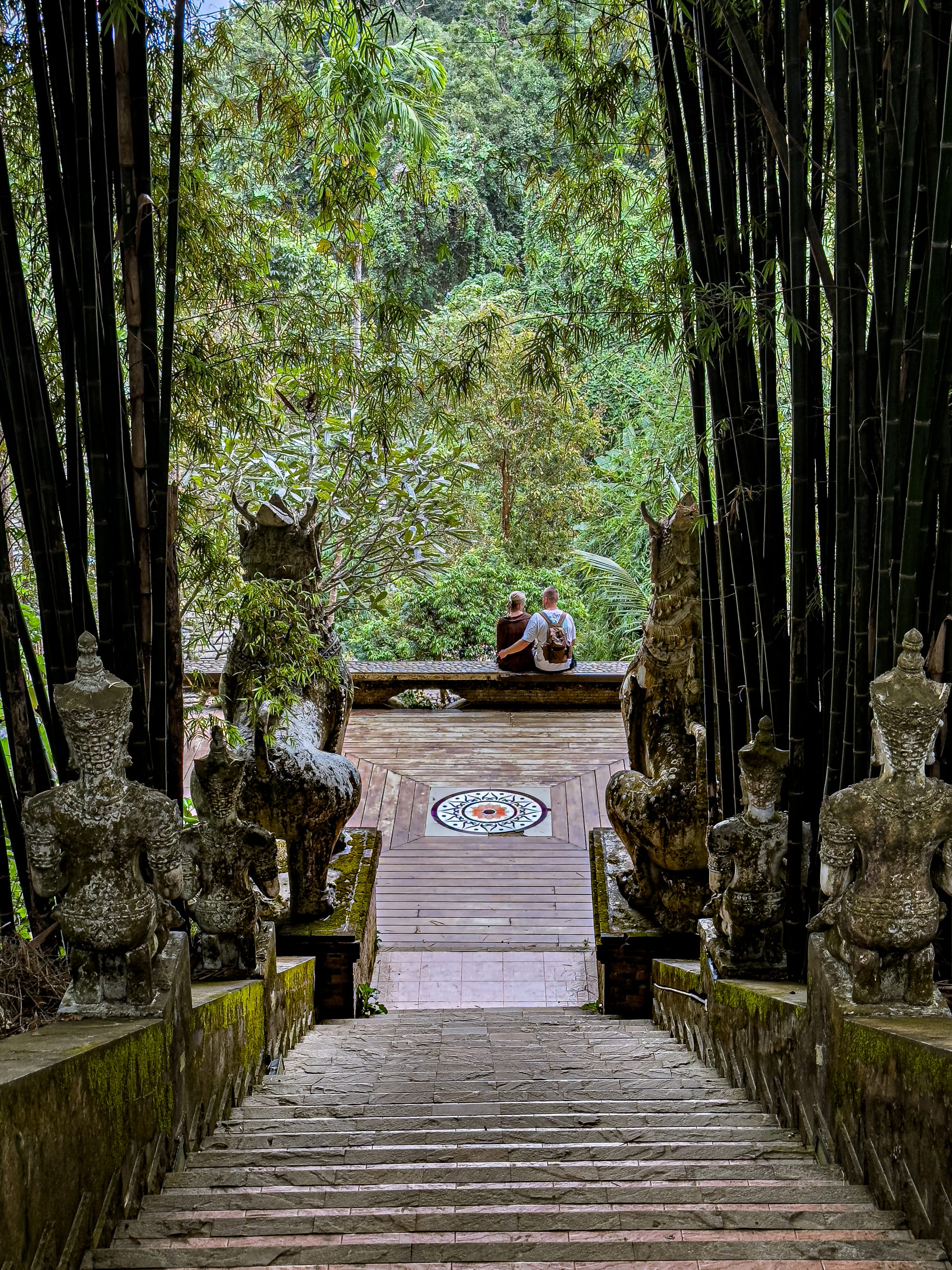
What makes Wat Pha Lat special isn’t grandeur but serenity. Unlike Chiang Mai’s busier temples, this one feels tucked into the landscape, almost secret. The sound of rushing water, the smell of damp earth, and the sight of weathered statues draped in offerings combine into an atmosphere that feels timeless.
Sticky Waterfall
A climbable cascade where the rocks grip instead of slip.
Officially called Bua Tong Waterfall, this unique spot about an hour and a half from Chiang Mai is famous for its mineral-coated rocks that feel rough underfoot, making them grippy rather than slick. That means you can actually climb directly up the flowing cascades barefoot, using ropes tied along the sides for support. The water is cool and clear, flowing down through layers of forest before joining the streams below.
It’s a playful, adventurous experience that feels different from a typical waterfall visit. Instead of standing back and taking photos, you’re clambering up natural steps with water rushing around you, pausing at pools to cool off. Surrounded by greenery and shaded by tall trees, the atmosphere is refreshing—especially on hot days. It’s a favorite among both locals and visitors for its mix of fun, novelty, and jungle calm.
Ethical elephant viewing
Observe rescued elephants in a sanctuary setting, not a show.
Chiang Mai is surrounded by elephant camps, but only a handful operate with genuine care for the animals. The most respected option is Elephant Nature Park, a sanctuary and rescue center where elephants roam in a natural environment free from rides, tricks, or performances. Visiting here means spending time walking alongside the elephants, watching them bathe, or simply observing them forage in the fields—an experience that’s as humbling as it is memorable.
The focus is firmly on rehabilitation and respect. Many of the elephants have been rescued from logging, circuses, or exploitative camps, and the park works to give them space, safety, and dignity. For visitors, it’s a chance to learn about the complex history of elephants in Thailand, support a more ethical approach to tourism, and still enjoy a magical, up-close encounter with these extraordinary animals.
Day trips and weekend getaways
Weekend getaway to Mae Rim
Countryside escape just outside Chiang Mai.
Just 45 minutes northwest of Chiang Mai, Mae Rim is the go-to spot when you want a break from the city without traveling far. The area is cooler, greener, and framed by rolling hills, with waterfalls, coffee shops, and forest trails spread out along winding mountain roads. It’s a favorite weekend retreat for both locals and nomads, offering a slower pace and fresh air that feels worlds away from the bustle of the Old City.
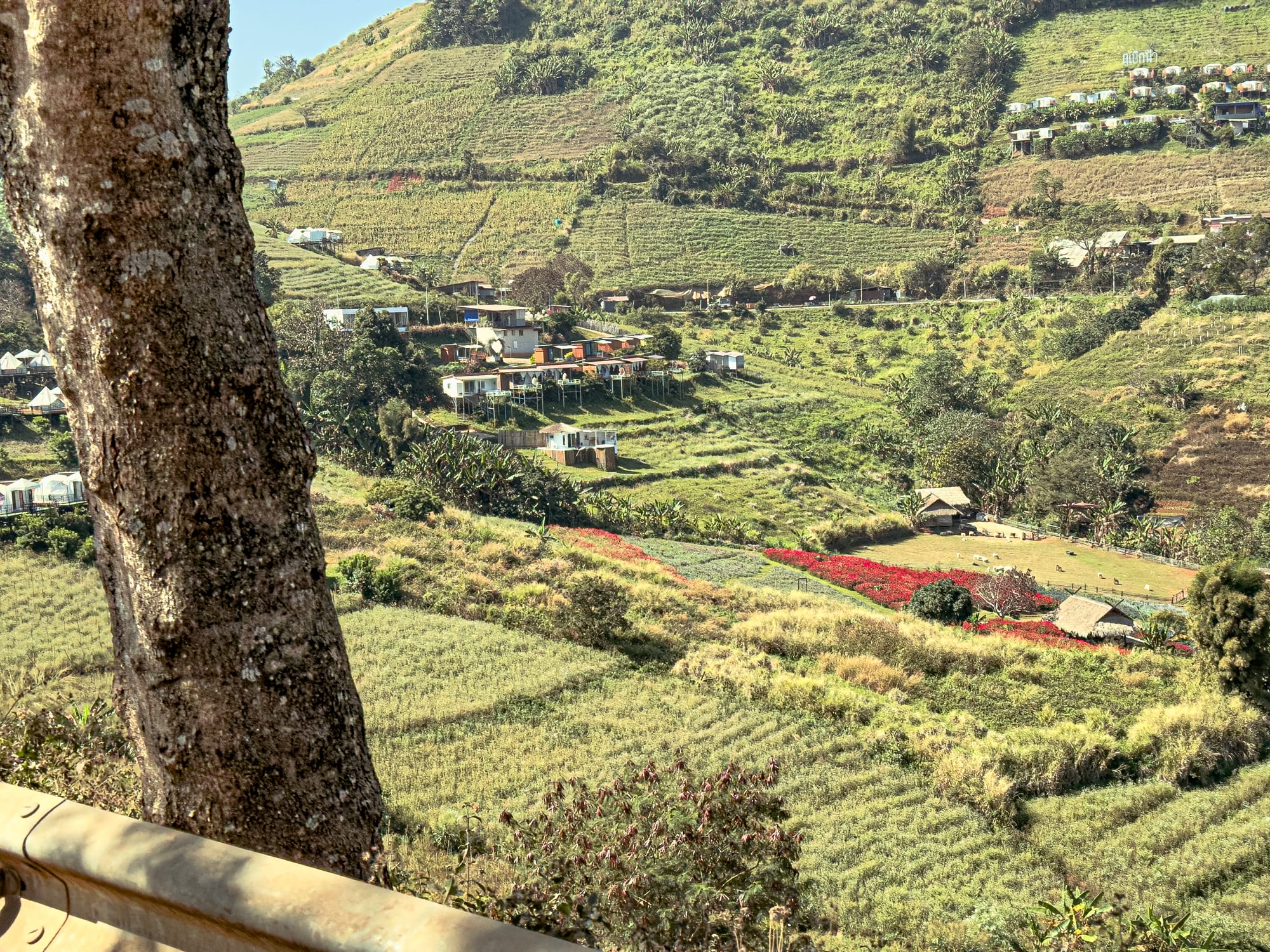
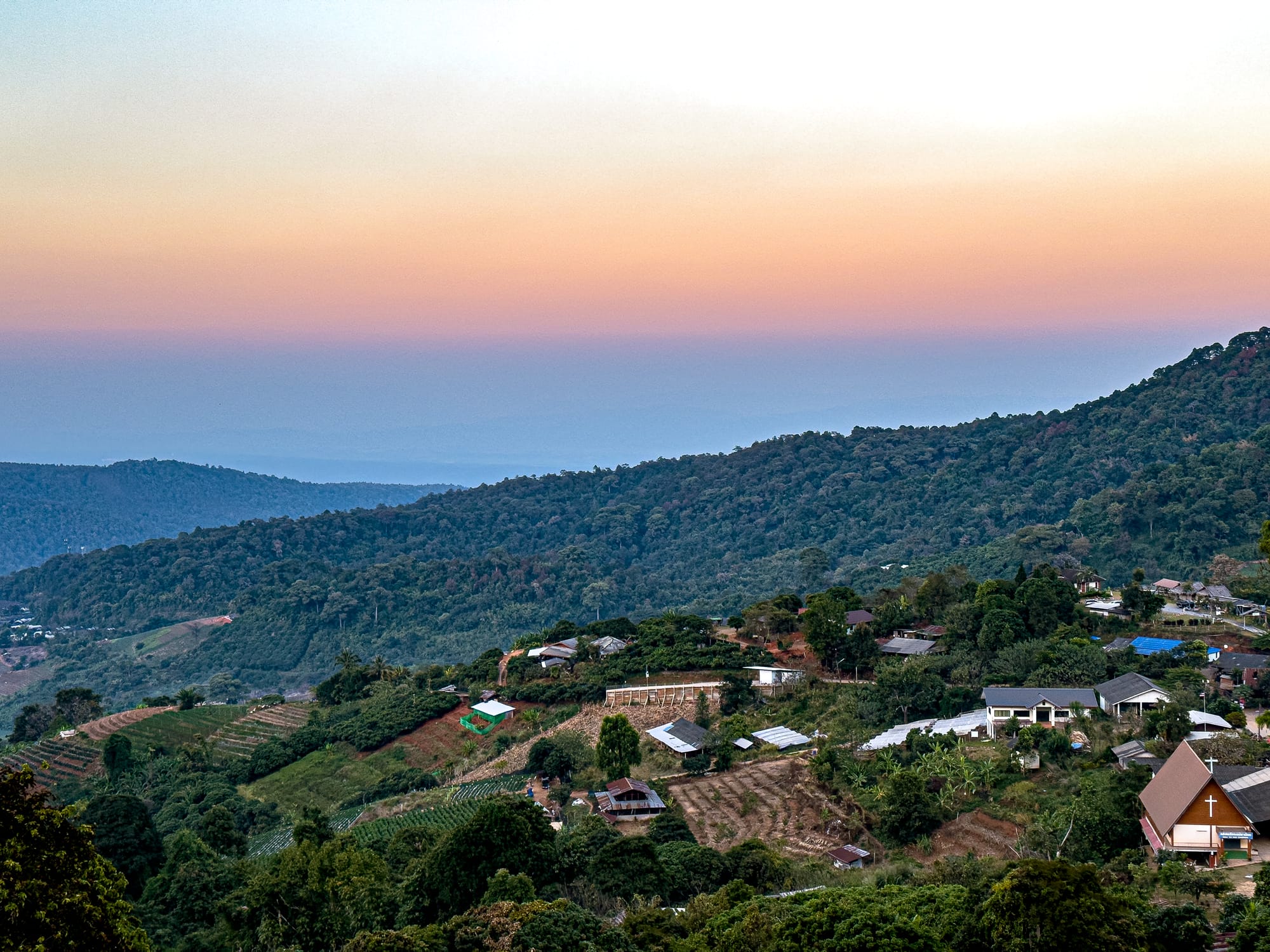
Highlights here include Queen Sirikit Botanic Garden, with its canopy walkway and orchid houses, and Mon Jam, where mountaintop flower farms overlook misty valleys. There are also plenty of cafés serving locally grown coffee, homestays with outdoor baths, and wellness spots like Onsen at Moncham tucked into the hills. Whether you’re after hiking, soaking, or simply relaxing with mountain views, Mae Rim makes it easy to fill a weekend with nature and calm.
Queen Sirikit Botanic Garden
Thailand’s landmark botanic garden in the hills of Mae Rim.
Set in the mountains of Mae Rim, Queen Sirikit Botanic Garden is one of the most beautiful and expansive green spaces in Northern Thailand. The garden spans forested hillsides, landscaped collections, and Southeast Asia’s longest canopy walkway—a suspended trail that lets you stroll above the treetops with sweeping views of the valley below. Inside, themed glasshouses showcase orchids, ferns, desert plants, and medicinal herbs, while outdoor trails lead you through shaded forest paths alive with birdsong.
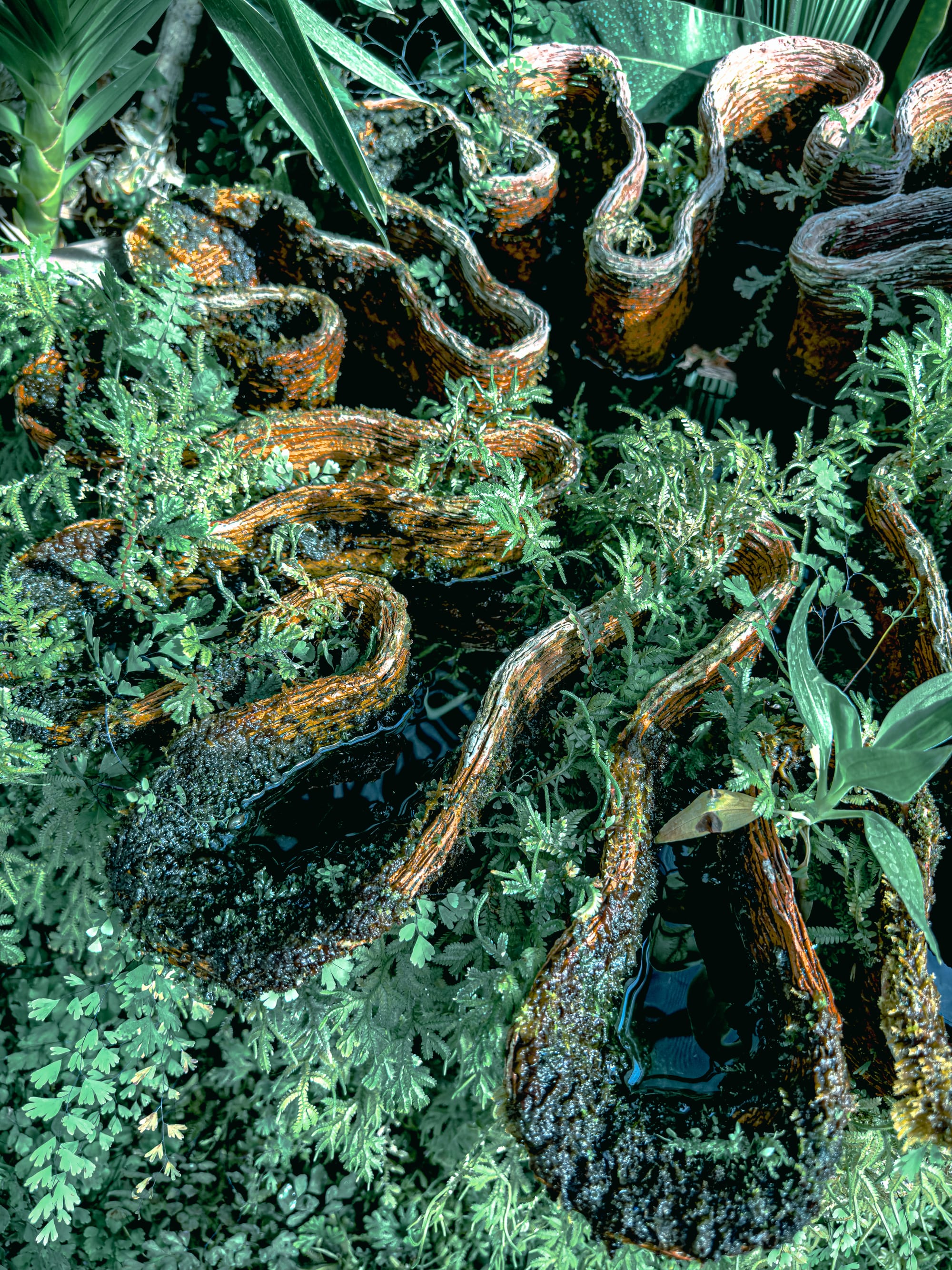
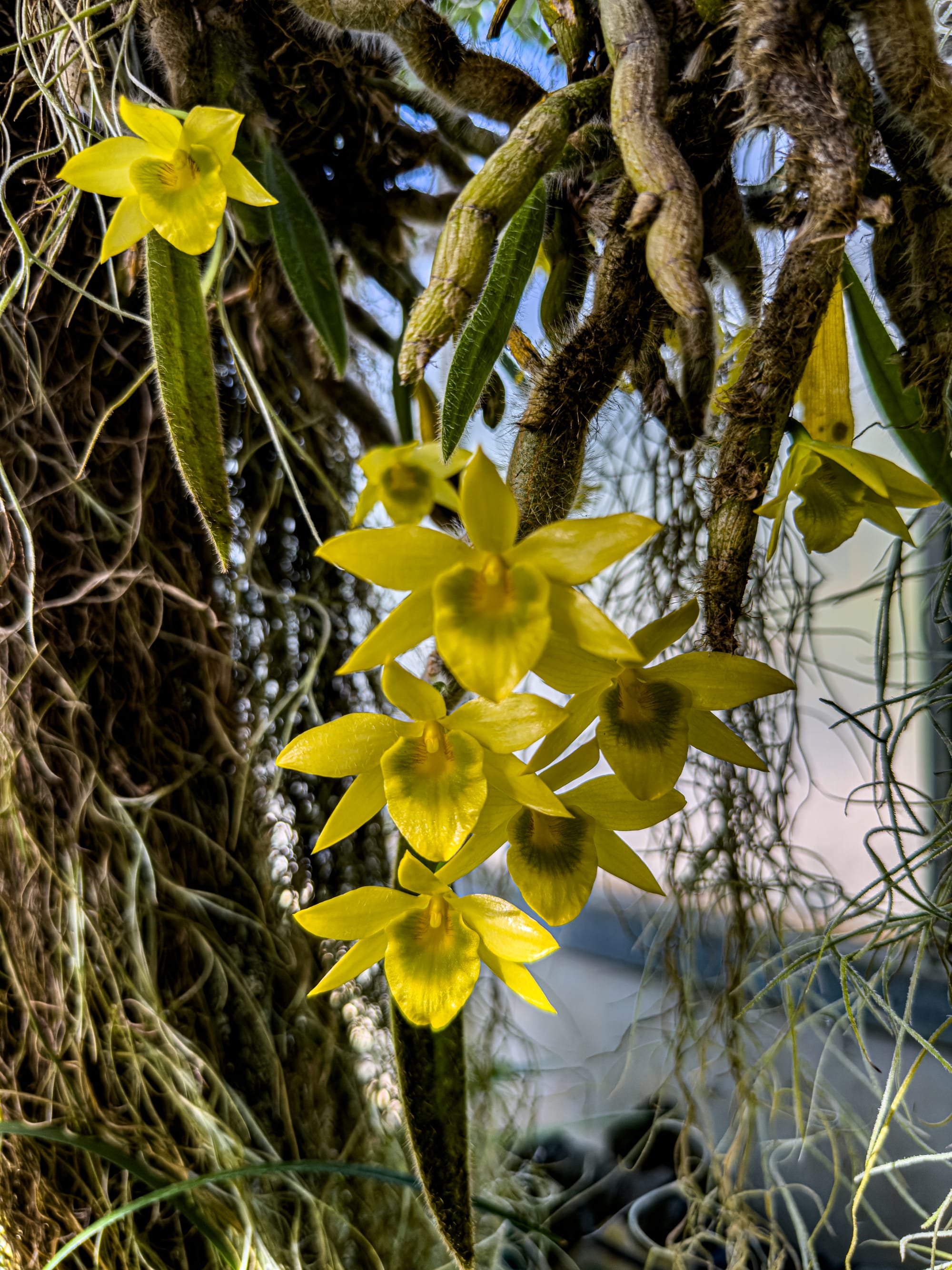
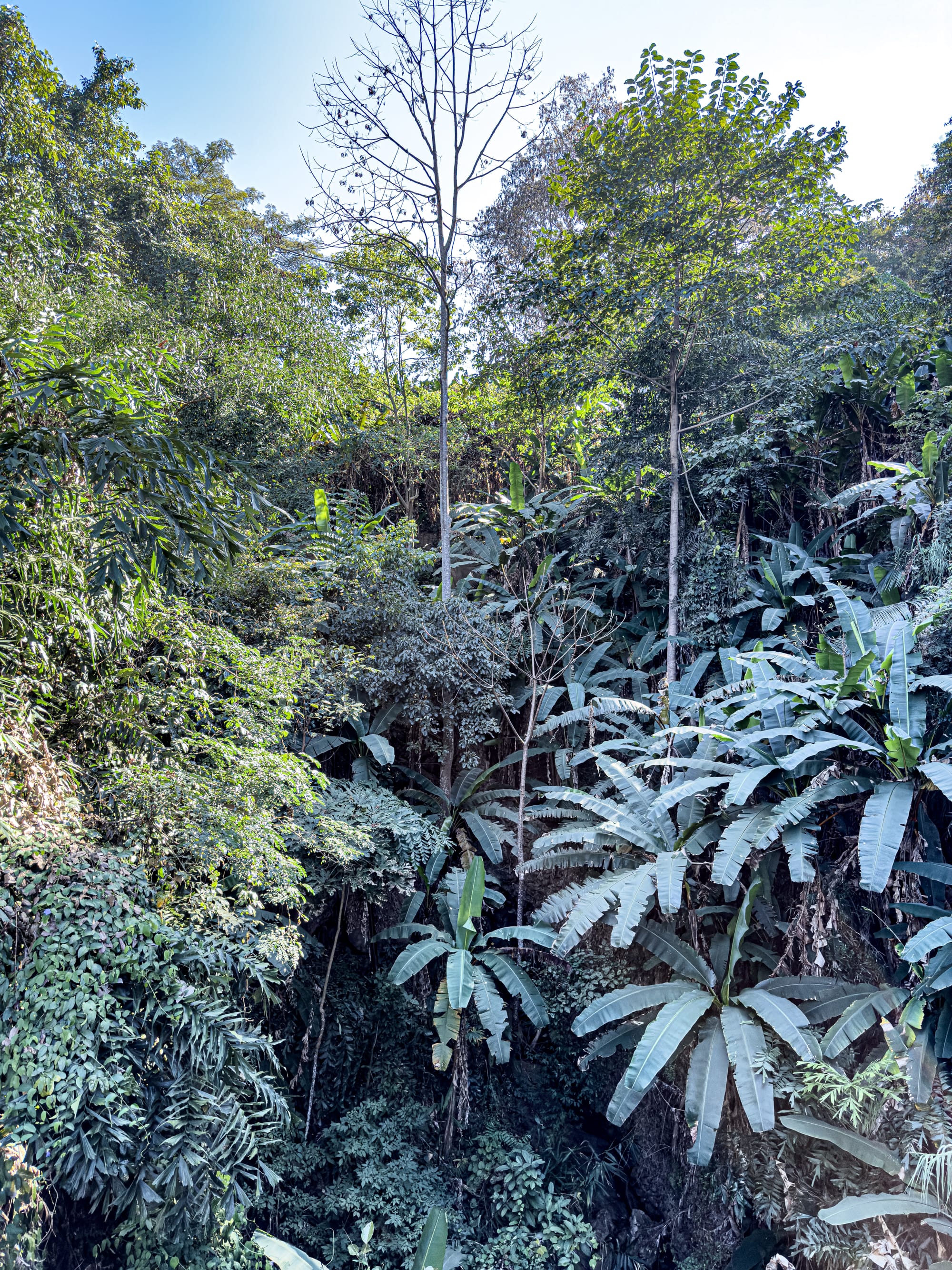
It’s easy to spend half a day here wandering between the lotus ponds, forest lookouts, and curated conservatories. The gardens blend conservation with education, highlighting Thailand’s incredible biodiversity while giving visitors a serene place to recharge. For us, the lotus collection was a standout—an otherworldly room filled with delicate blooms floating in still water. If you’re looking for a slower, more meditative escape, this is one of Chiang Mai’s most rewarding nature experiences.
Mon Jam’s mountaintop flower farms
Seasonal blooms with panoramic mountain views.
High in the hills of Mae Rim, Mon Jam is known for its sweeping views and colorful flower farms that cascade across the mountainsides. Small bamboo huts and winding paths frame fields of bright blossoms—cosmos, marigolds, and other seasonal flowers—that create a vivid contrast against the rolling green hills beyond. The cool mountain air makes it a refreshing break from the city, and the vantage points here are among the most photogenic in Chiang Mai.
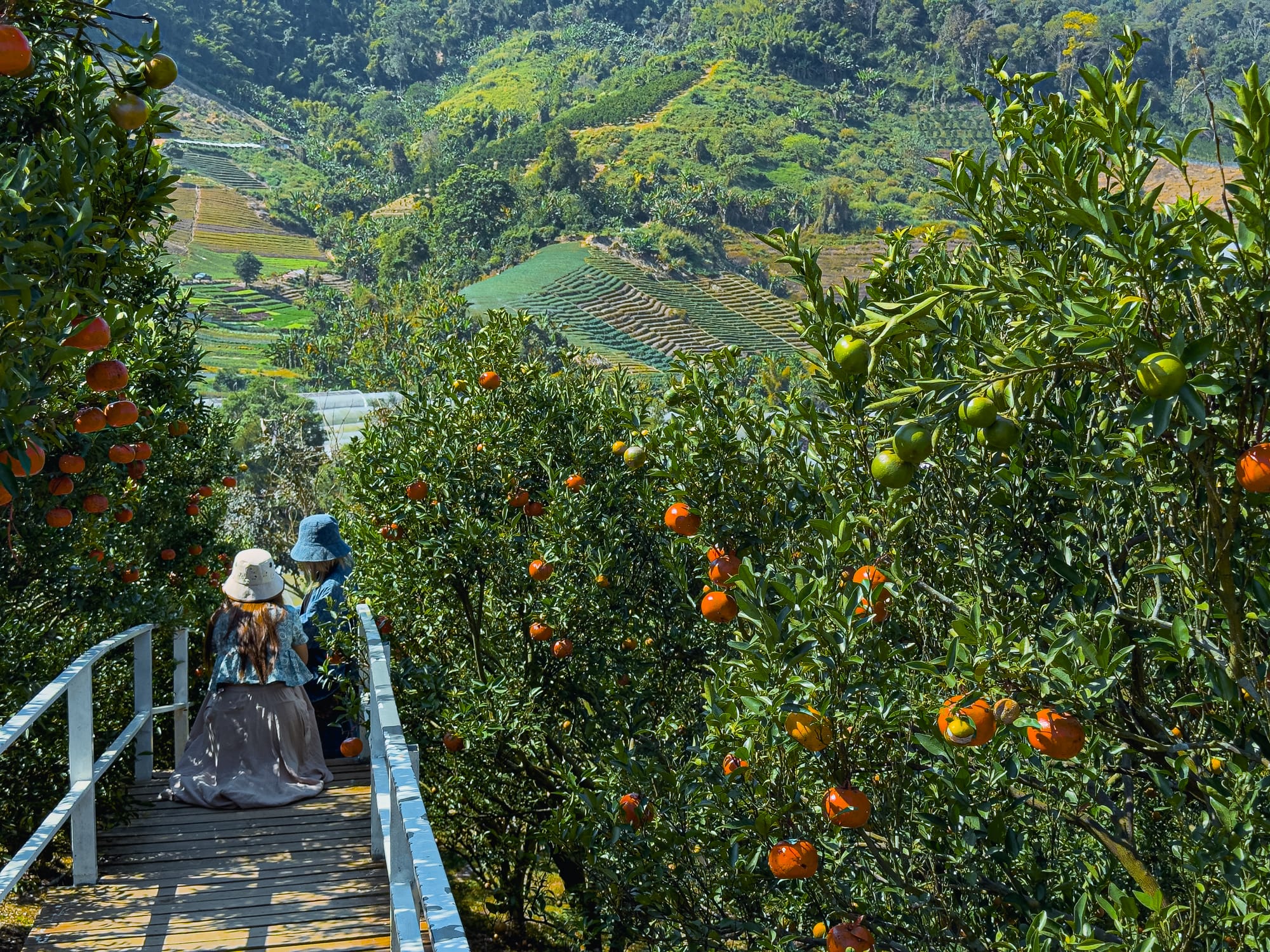
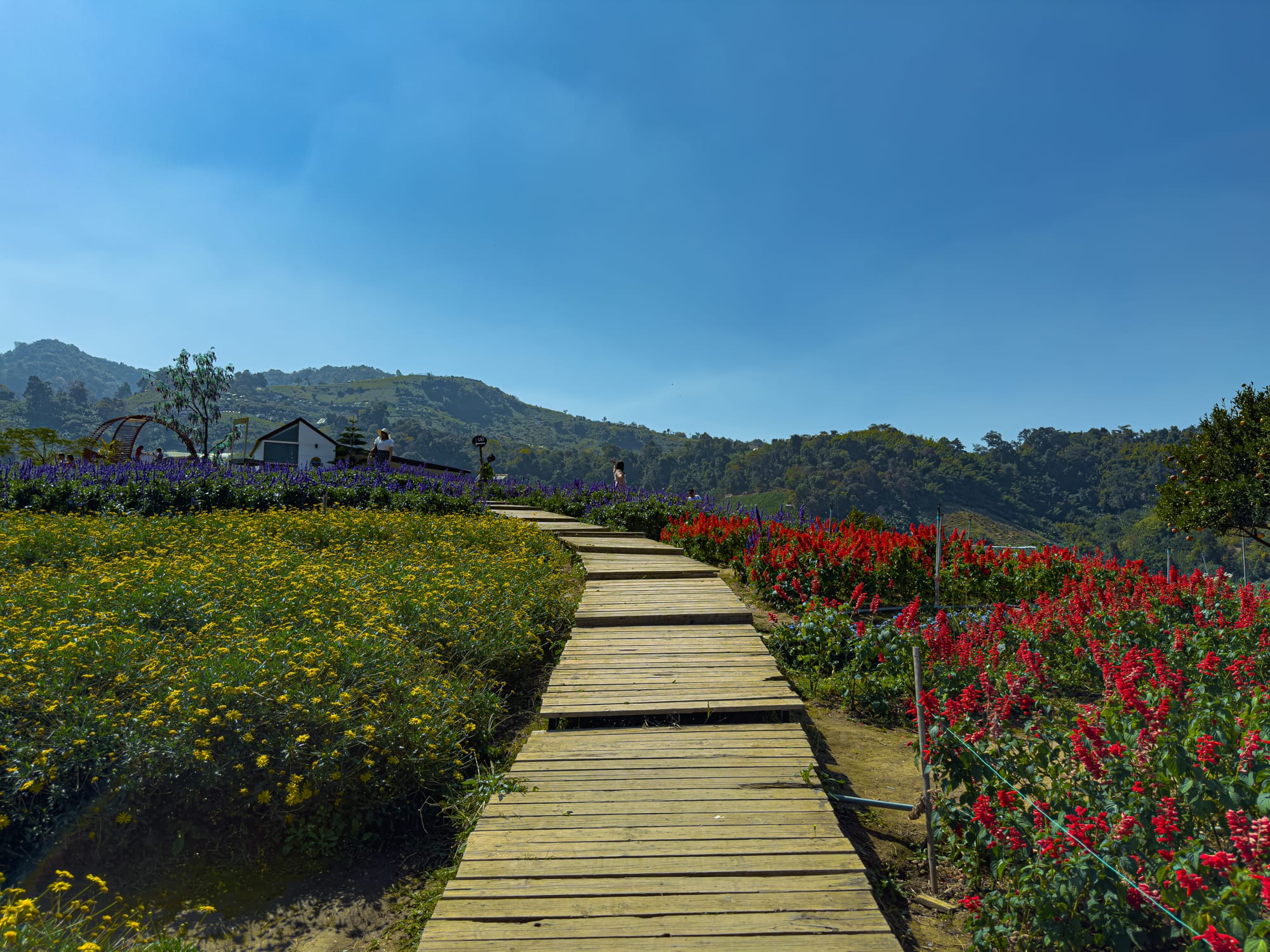
Beyond the blooms, Mon Jam carries a local charm. Food stalls line the ridges selling snacks, teas, and fresh produce, while the landscape itself is shaped by community agriculture and small-scale farming. Whether you visit in the morning for crisp light or late afternoon for golden hour, Mon Jam offers a blend of natural beauty and cultural texture that makes it one of the region’s most iconic countryside escapes.
Pai
A mountain town of hot springs, waterfalls, and slow rhythms.
About three hours north of Chiang Mai, Pai is a small valley town that has become a favorite weekend getaway for travelers and nomads alike. The road there is famously winding, with 762 curves cutting through the mountains—an adventure in itself. Once you arrive, the pace slows. Pai is known for its relaxed cafés, local markets, and surrounding countryside dotted with hot springs, waterfalls, and bamboo bridges stretching across rice fields.
Evenings in Pai often center around its lively walking street, where food stalls, handmade crafts, and music fill the air. By day, you can soak in a natural hot spring, trek to a nearby waterfall, or simply rent a scooter and wander through the hills. It’s not a place to rush through—Pai’s appeal lies in its laid-back atmosphere and the mix of nature and community that makes every visit feel like a retreat.
Chiang Rai’s White and Blue temples
Surreal architecture and sacred art a few hours north of Chiang Mai.
Chiang Rai, a province bordering Laos and Myanmar, is best known for its pair of striking modern temples that have become icons of northern Thailand. The White Temple, or Wat Rong Khun, is a dazzling creation by artist Chalermchai Kositpipat—its gleaming white façade inlaid with mirrored glass depicts a surreal blend of Buddhist symbolism and contemporary references. Nearby, the Blue Temple, or Wat Rong Suea Ten, glows with deep cobalt walls and ceilings, its interiors filled with intricate murals and a serene white Buddha.
Visiting both makes for a memorable day trip from Chiang Mai, whether you hire a driver or join an organized tour. The contrast between their colors and styles is part of the experience: the White Temple feels otherworldly and almost futuristic, while the Blue Temple radiates warmth and devotion.
Doi Inthanon National Park
Thailand’s highest peak, waterfalls, and cloud-covered trails.
About two hours from Chiang Mai, Doi Inthanon National Park is a must for anyone wanting a mix of mountain scenery, waterfalls, and forest walks. At its heart is Doi Inthanon itself, the tallest mountain in Thailand at 2,565 meters, surrounded by cool mist and evergreen forest. Highlights include Wachirathan and Siriphum waterfalls, the short but scenic Ang Ka Nature Trail through mossy cloud forest, and viewpoints that rise above the clouds on clear mornings.
Near the summit, you’ll also find the King and Queen pagodas—twin monuments surrounded by gardens that frame sweeping vistas of the surrounding mountains. The park can be visited in a day, though it’s worth going early to avoid crowds and to catch the soft light over the landscape. Whether you’re into hiking, photography, or simply escaping Chiang Mai’s heat, Doi Inthanon offers a refreshing shift in pace and altitude.
Local culture and cuisine
Explore temples
Wander through Chiang Mai’s rich spiritual heritage.
Known as the “city of temples,” Chiang Mai is home to more than 300 wats, each with its own history and style. Within the Old City, you’ll find some of the most famous—like Wat Phra Singh with its Lanna-style architecture, and Wat Chedi Luang with its towering ruined stupa. Spending an afternoon on foot lets you soak in golden spires, intricate wood carvings, and the daily rhythm of monks in saffron robes moving between shrines.
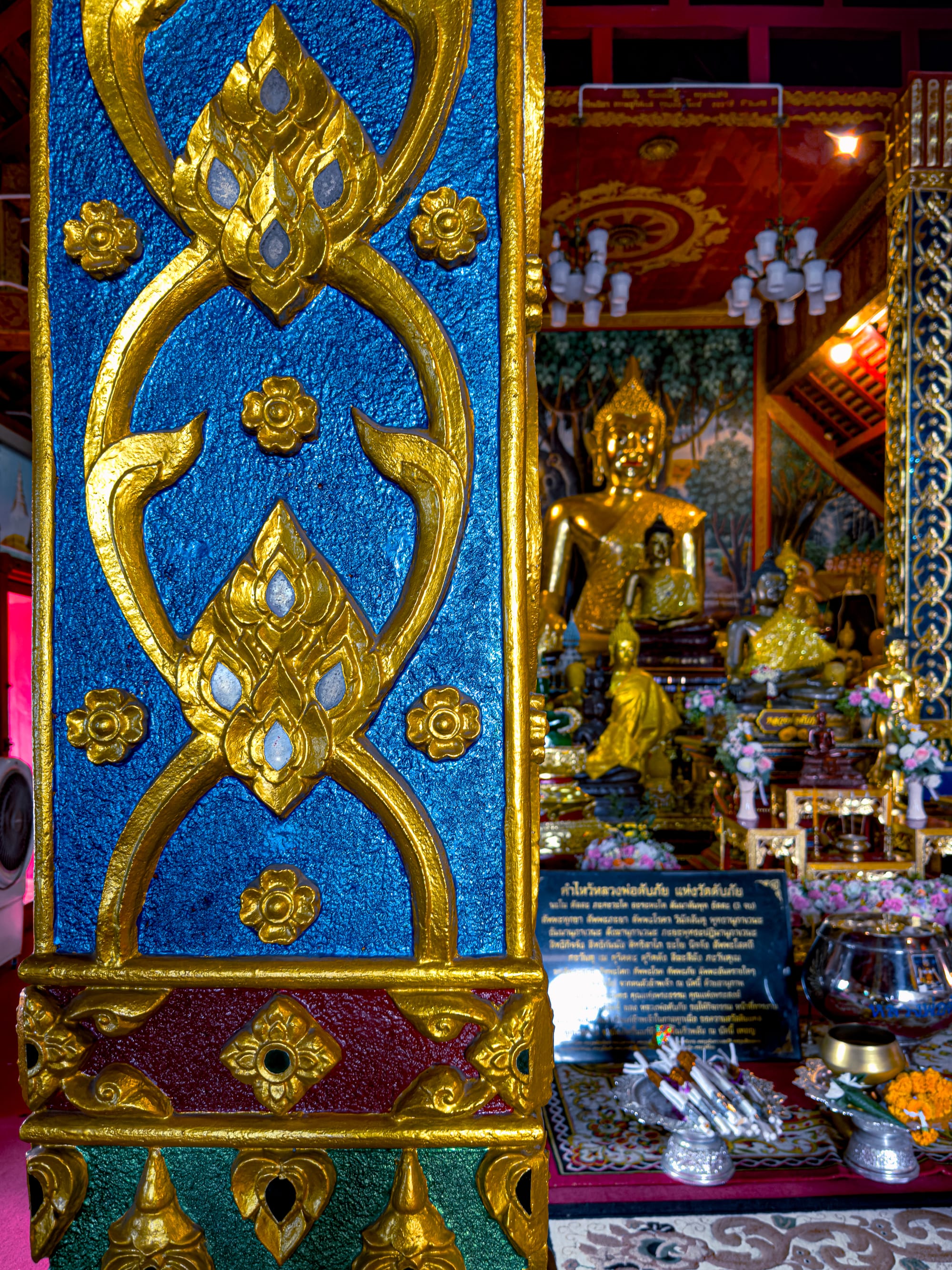
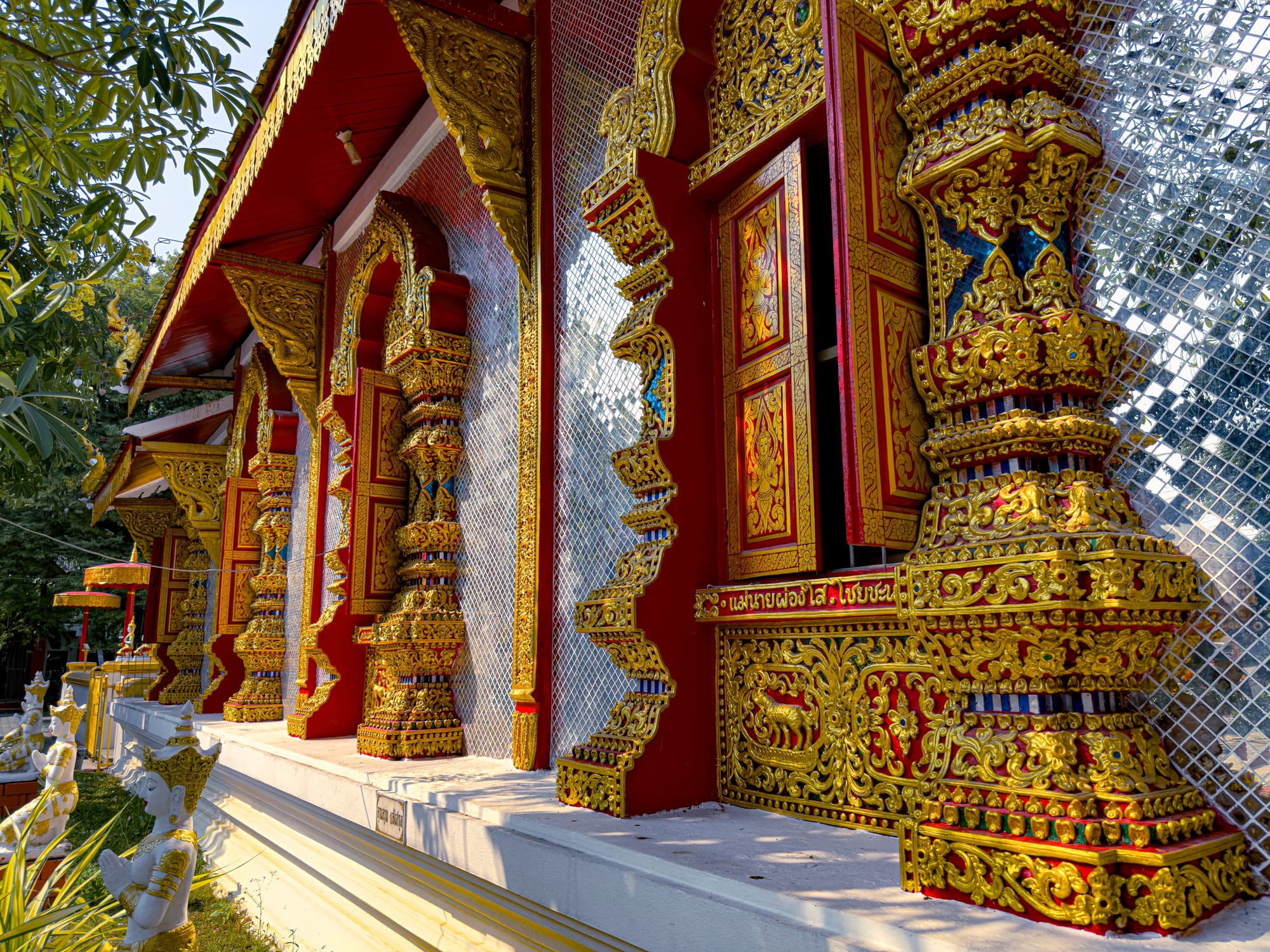
Temples here aren’t just tourist sights—they’re active centers of community and spirituality. Incense drifts through the air, locals stop to make offerings, and bells chime softly in courtyards. Whether you step inside for quiet reflection or simply admire the architecture from outside, exploring Chiang Mai’s temples offers a window into northern Thailand’s cultural and religious heart.
May Kaidee’s vegan cooking class
Learn plant-based Thai cooking with a legendary touch.
May Kaidee is one of Chiang Mai’s most beloved names in vegan cuisine, and her cooking classes are as nourishing as they are fun. The experience begins with an abundance of fresh vegetables and herbs, laid out in generous spreads that feel more like a feast than a classroom. Under the guidance a warm instructor, you’ll learn to prepare Thai classics—pad thai, curries, spring rolls, and mango sticky rice—entirely plant-based.
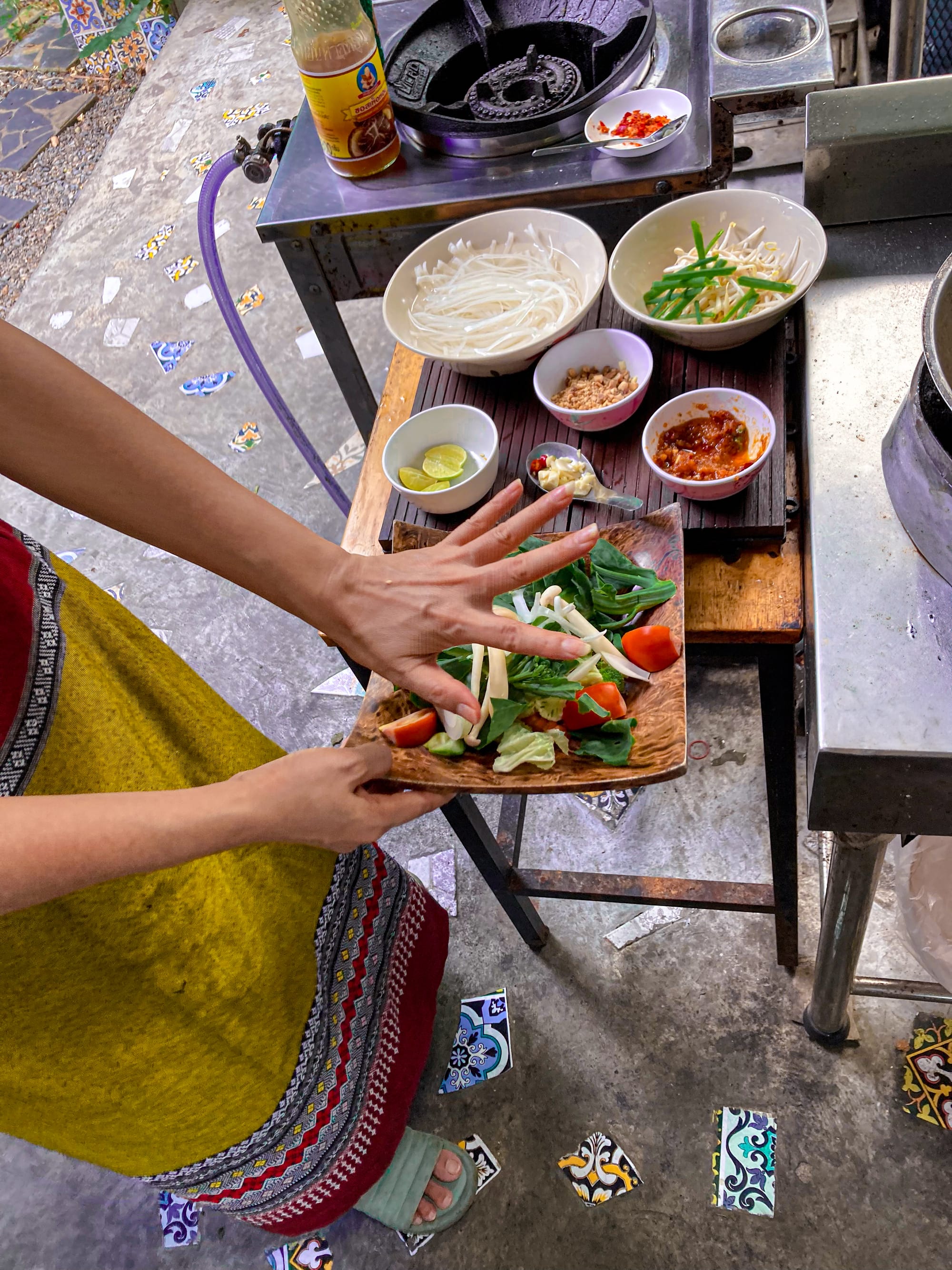
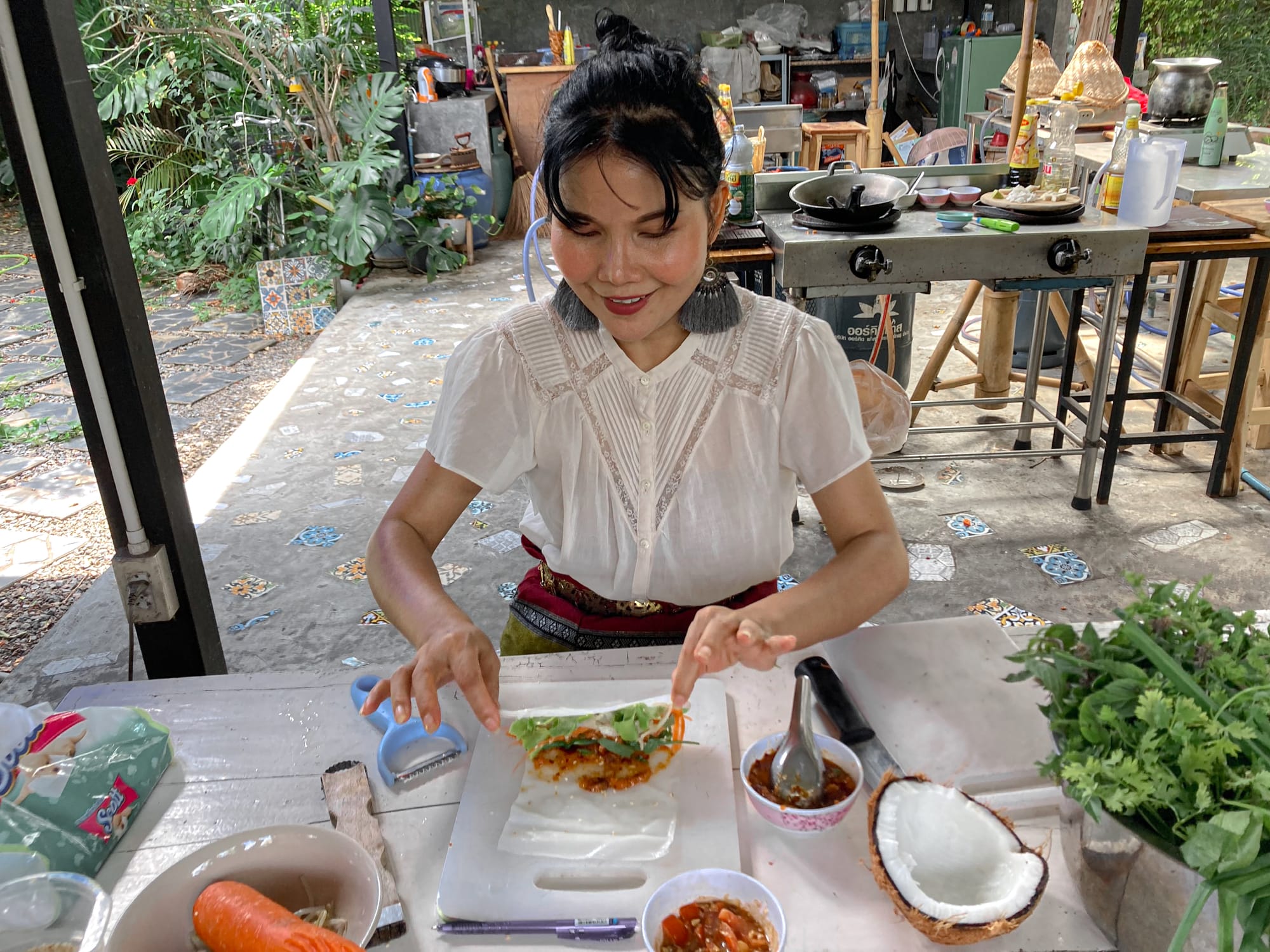
What makes the class special is the focus on balance and flavor. You’ll dive into the essentials of Thai cooking—sour, sweet, salty, and spicy—and see how they come together in sauces and curries. Everything is clean, fresh, and thoughtfully sourced, down to raw sugarcane paste instead of refined sugar. By the end, you’ll leave with a full stomach, leftovers to take home, and a skill set you can carry far beyond Chiang Mai.
Bird’s Nest
Bohemian café in the Old City with a creative, veggie-forward menu.
Bird’s Nest has been a Chiang Mai favorite for years, blending a cozy, handmade aesthetic with a relaxed, artsy vibe. Woven lampshades, painted murals, and leafy corners make it feel more like a living room than a café, perfect for settling in with a book or lingering over conversation. The atmosphere is easygoing, a little bohemian, and unmistakably local.
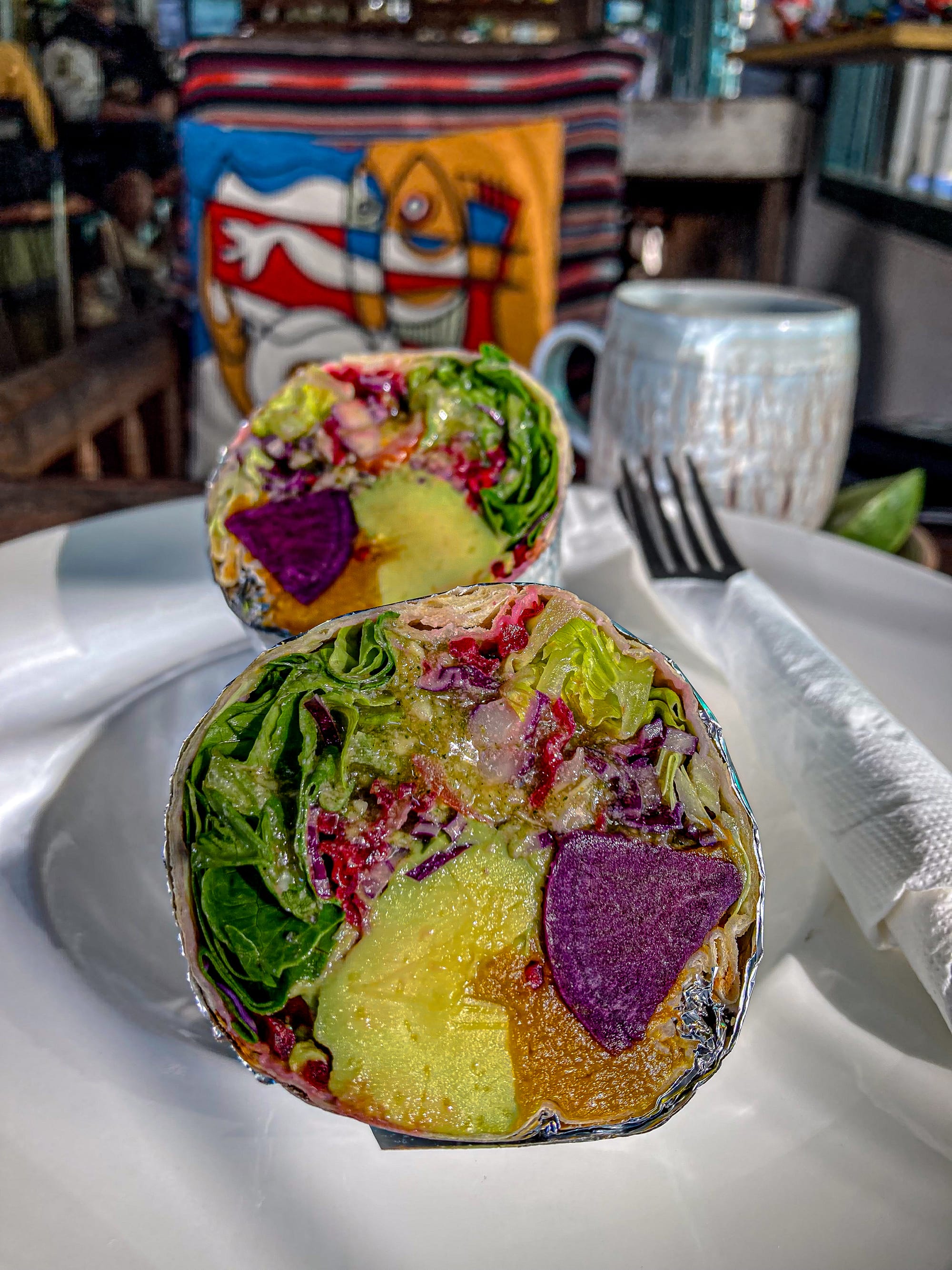
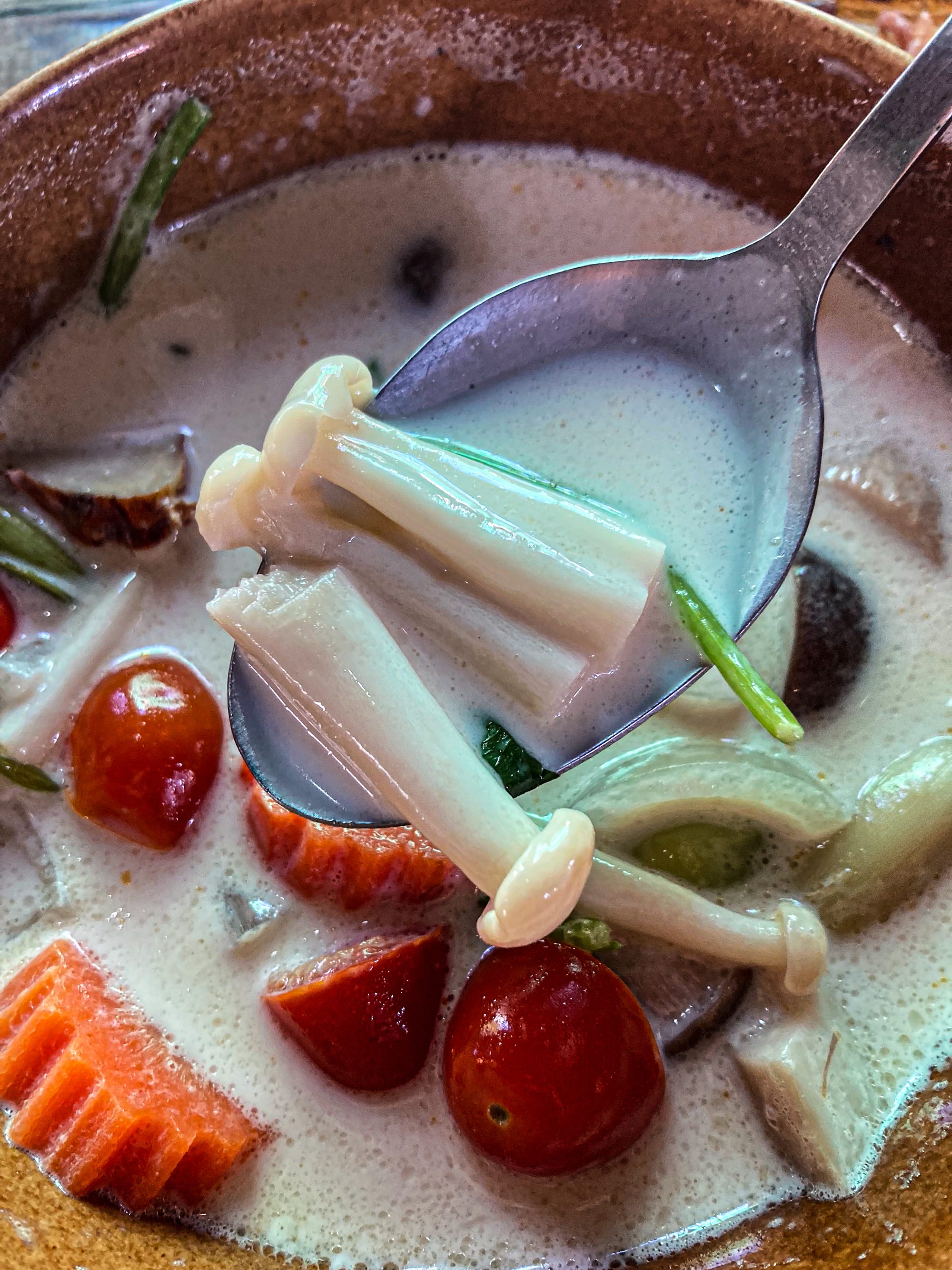
The menu leans heavily vegetarian and vegan, with colorful curries, rice bowls, fresh smoothies, and their much-loved homemade chili sauce. Much of the produce is sourced from local organic farms—or even grown by the café itself—making every dish feel fresh and intentional. Bird’s Nest has a way of turning simple meals and slow afternoons into highlights in themselves.
Vegan food in Chiang Mai
One of Southeast Asia’s most vibrant vegan dining scenes.
Chiang Mai has earned its reputation as a vegan paradise. Dozens of cafés and restaurants across the city focus entirely on plant-based menus, while many others offer vegan-friendly options that don’t feel like afterthoughts. The city’s Buddhist roots, reliance on fresh herbs, and long tradition of vegetable-forward dishes all blend into a food culture where plant-based eating feels natural rather than niche.
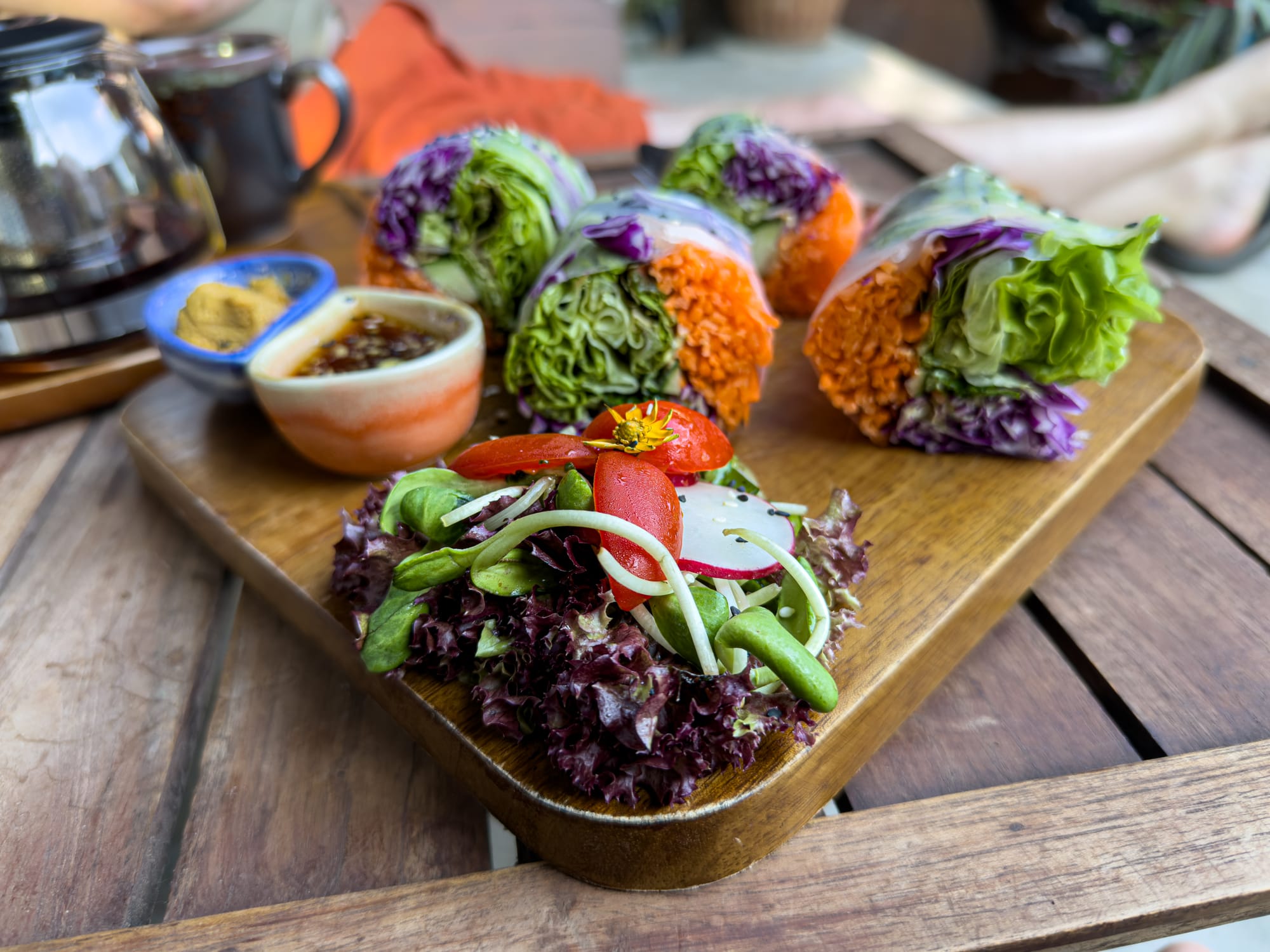
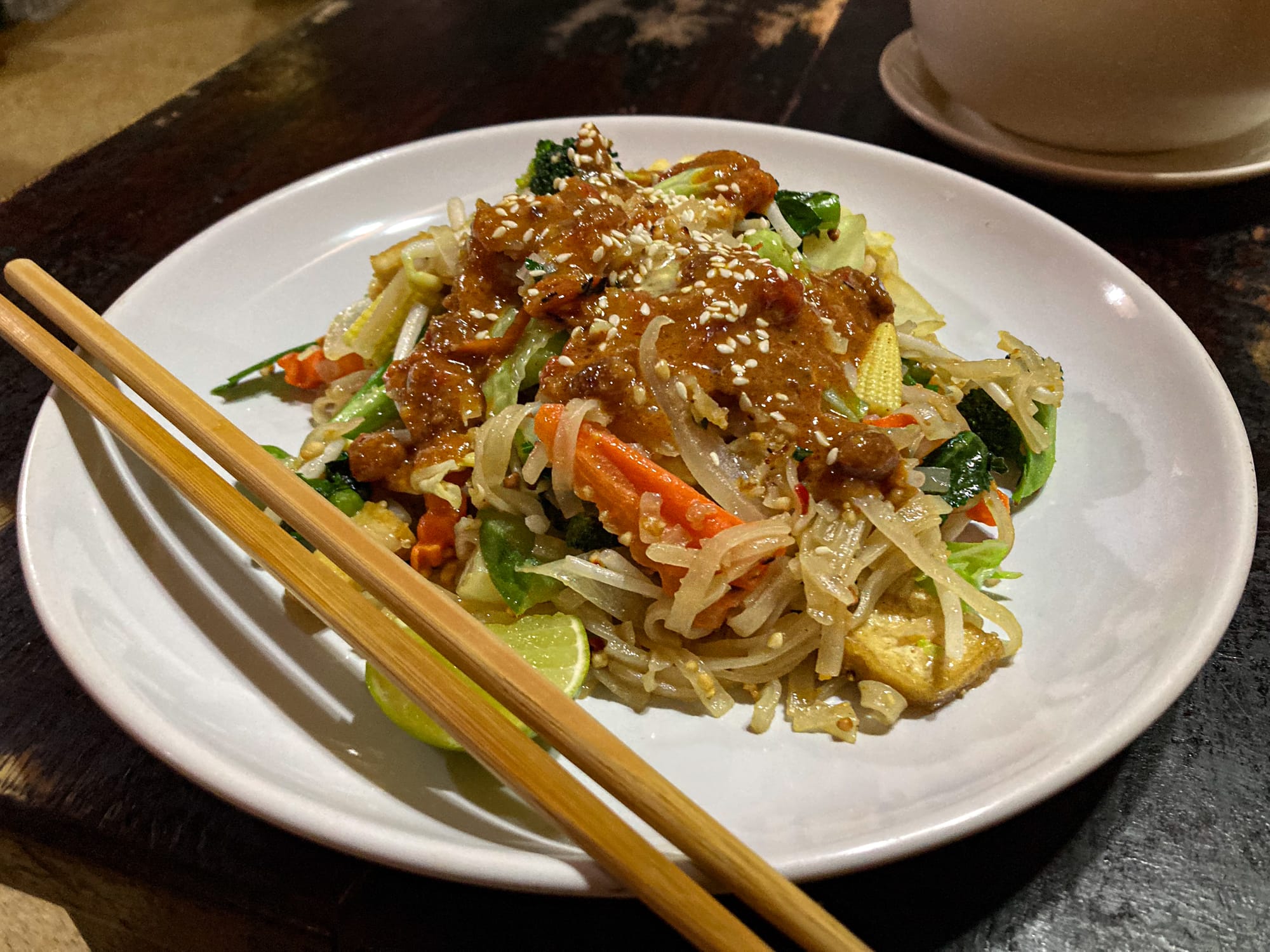
Whether you’re tucking into a fully vegan khao soi, exploring creative fusion plates at modern cafés, or sampling raw desserts and smoothie bowls, Chiang Mai’s vegan scene is both abundant and inventive.
North Gate Jazz Co-Op
Live music spilling into the street beside the Old City moat.
One of Chiang Mai’s best-loved night spots, North Gate Jazz Co-Op has become a staple for both locals and travelers. Tucked against the Old City moat, the venue is small and unpretentious, with music that often pours out onto the sidewalk as crowds gather outside. On any given night you’ll find a mix of local talent and international musicians jamming together, creating an atmosphere that feels spontaneous and electric.
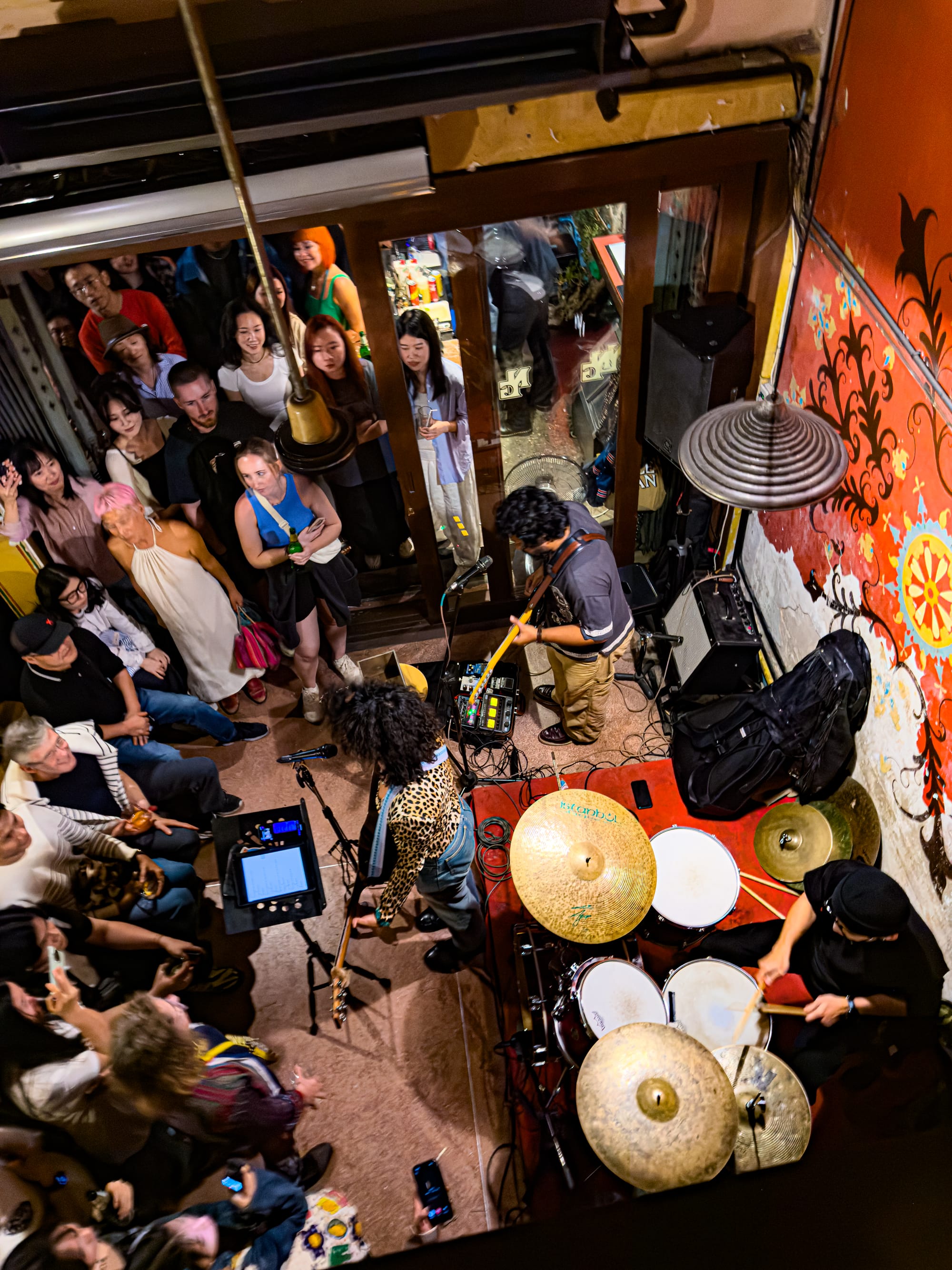
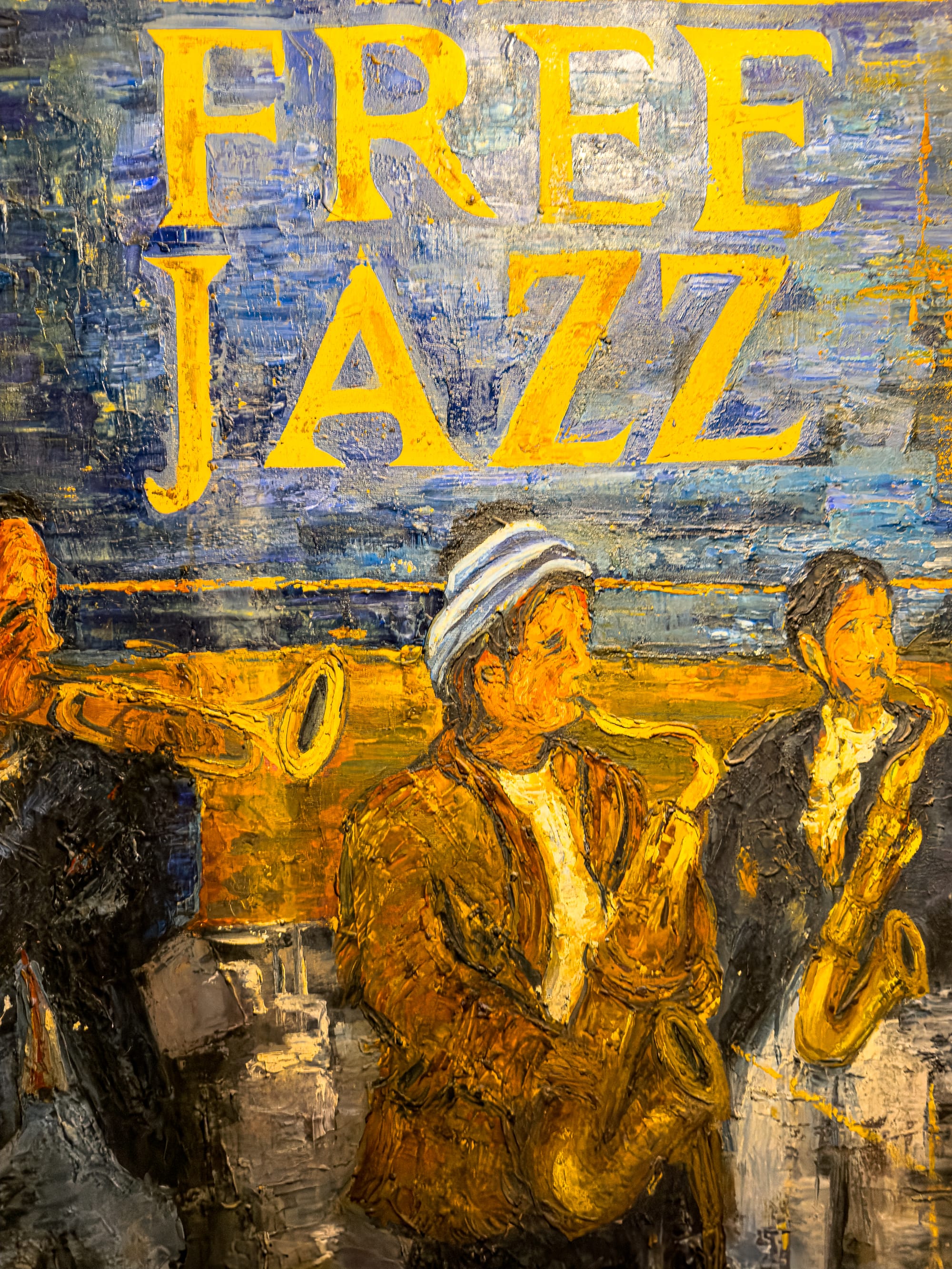
The energy here is casual and welcoming—you don’t need to be a jazz aficionado to enjoy it. People come to soak in the live music, chat with friends, and be part of a scene that feels both grounded in Chiang Mai and globally connected. It’s usually packed, so arrive early if you want a seat inside. Even if you end up standing in the street, the vibe is unforgettable.
Wellness and relaxation
Cocoon
A wellness garden with herbal steam, sauna, and firelit evenings.
Just south of Chiang Mai’s Old City, Cocoon feels more like a sanctuary than a spa. The architecture itself—curved, organic, and built from natural materials—sets the tone for a space that blends sacred geometry with a laid-back, creative atmosphere. Herbal steam rooms are infused with fresh plants picked from the property, while the saltwater pool, hot sauna, and ice baths invite a full cycle of relaxation.
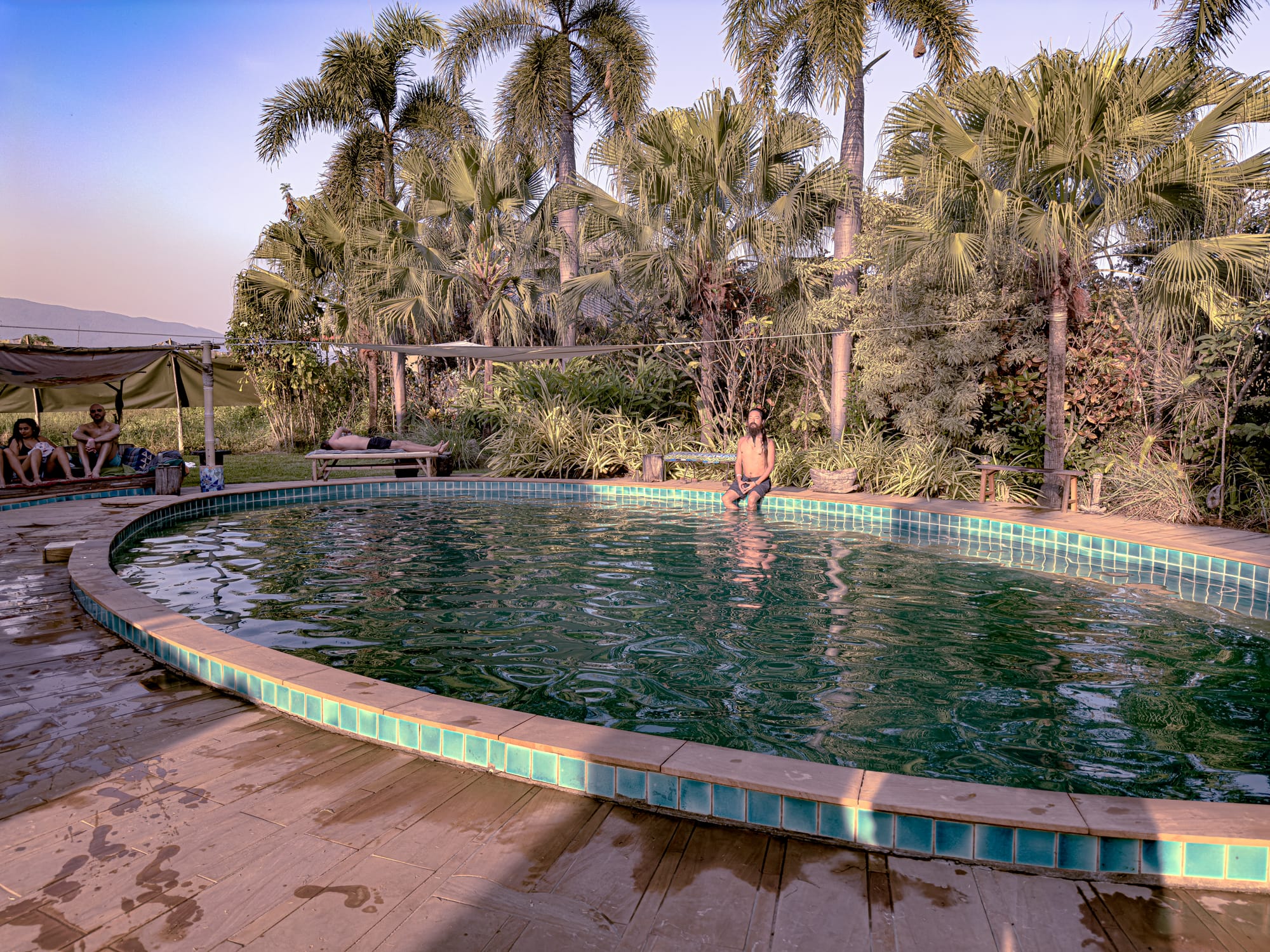
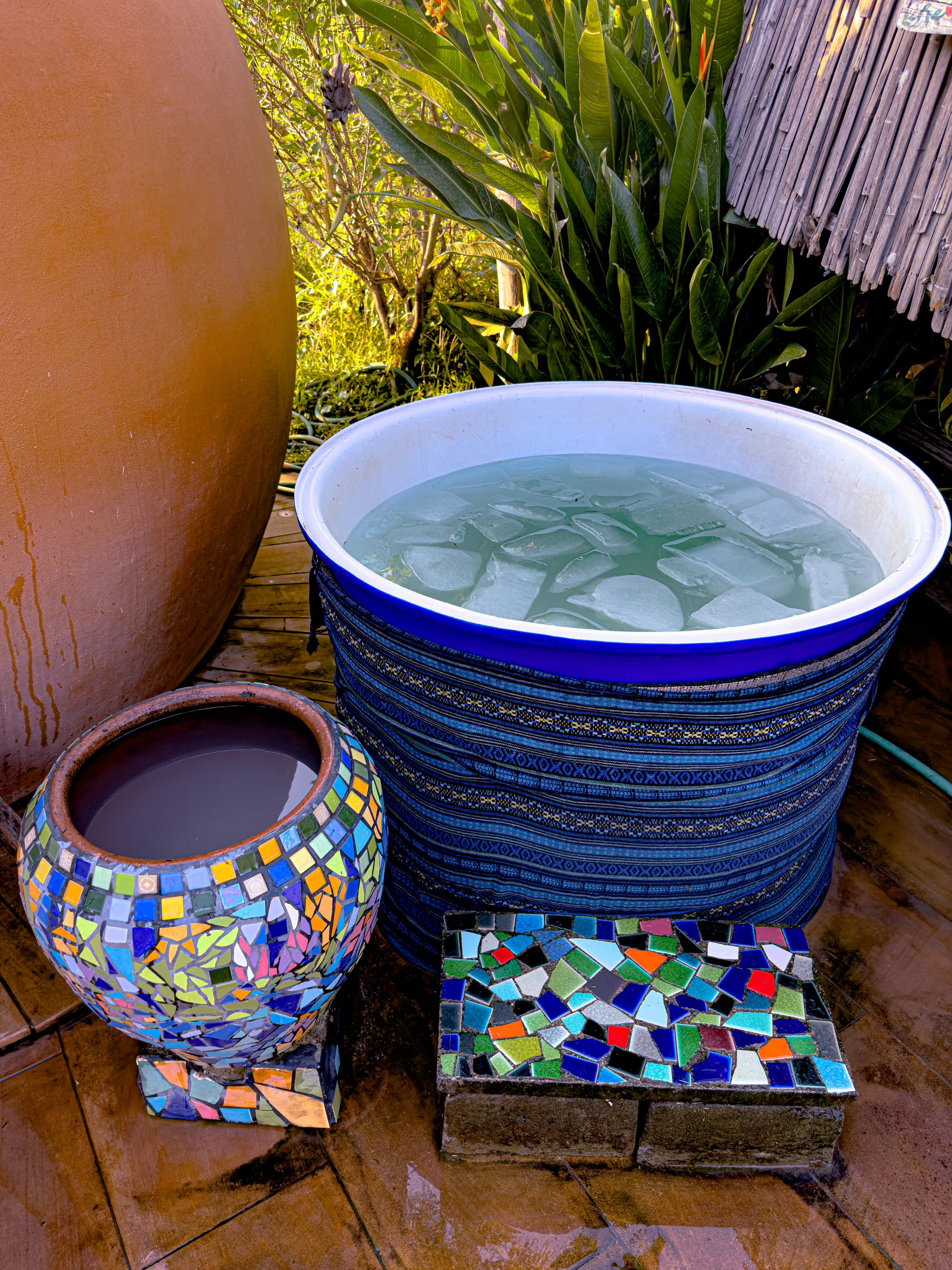
Beyond the facilities, Cocoon has a social yet serene vibe. On certain evenings you might find a bonfire lit in the garden, with herbal tea served as people gather in the glow. The crowd tends to be eclectic and free-spirited, drawn by the mix of wellness and community.
Old City Spa
A thermal circuit in the heart of Chiang Mai’s Old City.
Steps from the moat, Old City Spa offers one of the most comprehensive wellness experiences in Chiang Mai. The setup is all about cycles: a Thai herbal steam room, both infrared and Finnish saunas, an ice bath, and a magnesium hot tub. You can rotate between hot and cold as often as you like, leaving you both deeply relaxed and unexpectedly energized.
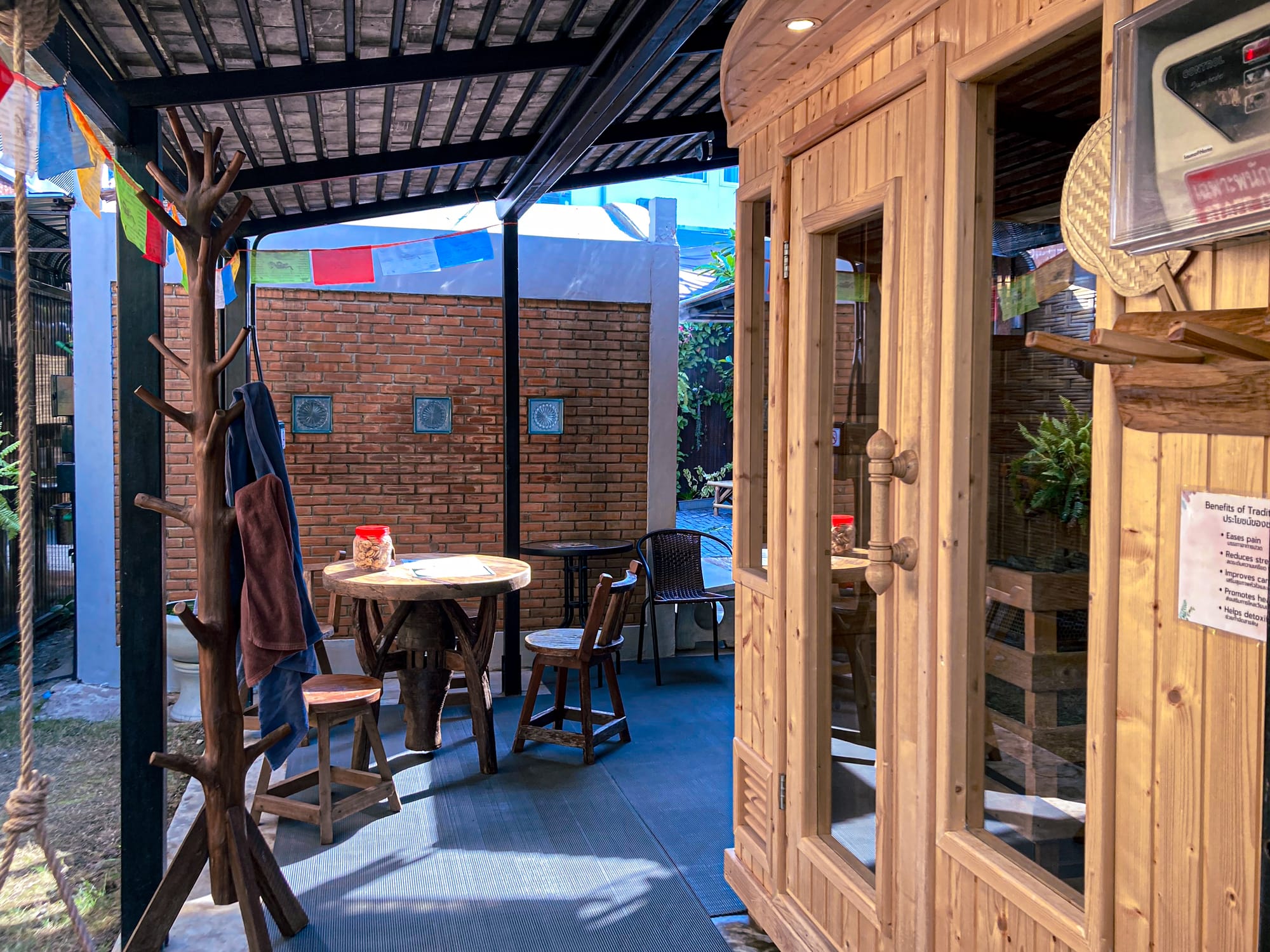
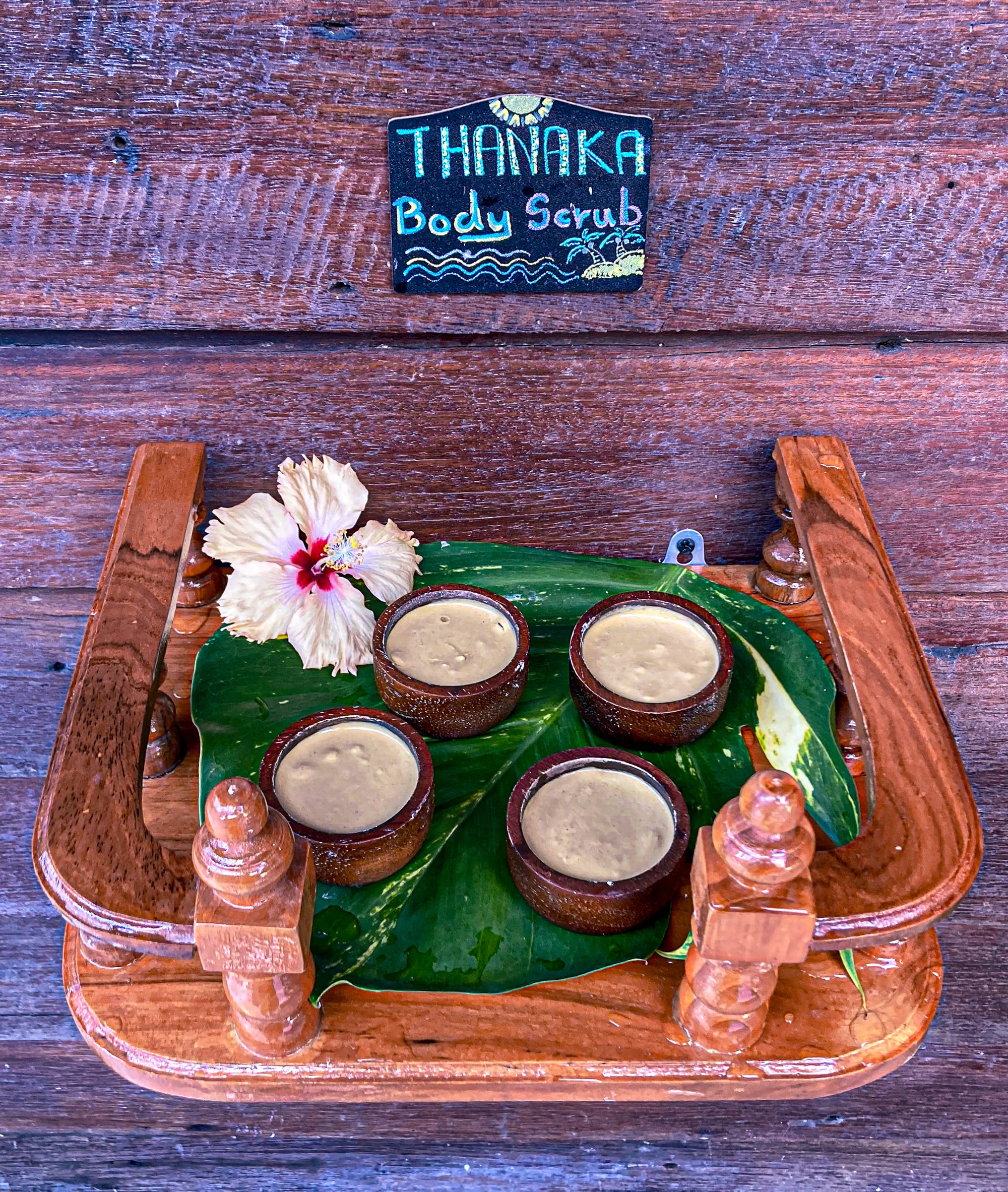
The spa provides sarongs if you don’t want to bring swimwear, so you can slip straight into the routine without fuss. With its lush greenery, gentle lighting, and steady flow of local herbs, the atmosphere is calm and restorative—perfect after a long day of temple visits or laptop work. For many nomads, Old City Spa becomes a reliable go-to for wellness right in the city center.
Onsen at Moncham
A Japanese-inspired hot spring retreat in the Chiang Mai mountains.
Set in the hills of Mae Rim, Onsen at Moncham feels worlds away from the bustle of the city. Modeled after traditional Japanese onsens, the resort offers mineral hot pools, saunas, and cold plunges framed by sweeping mountain views. It’s a serene spot to slow down, soak, and savor the quiet cool of the highlands.
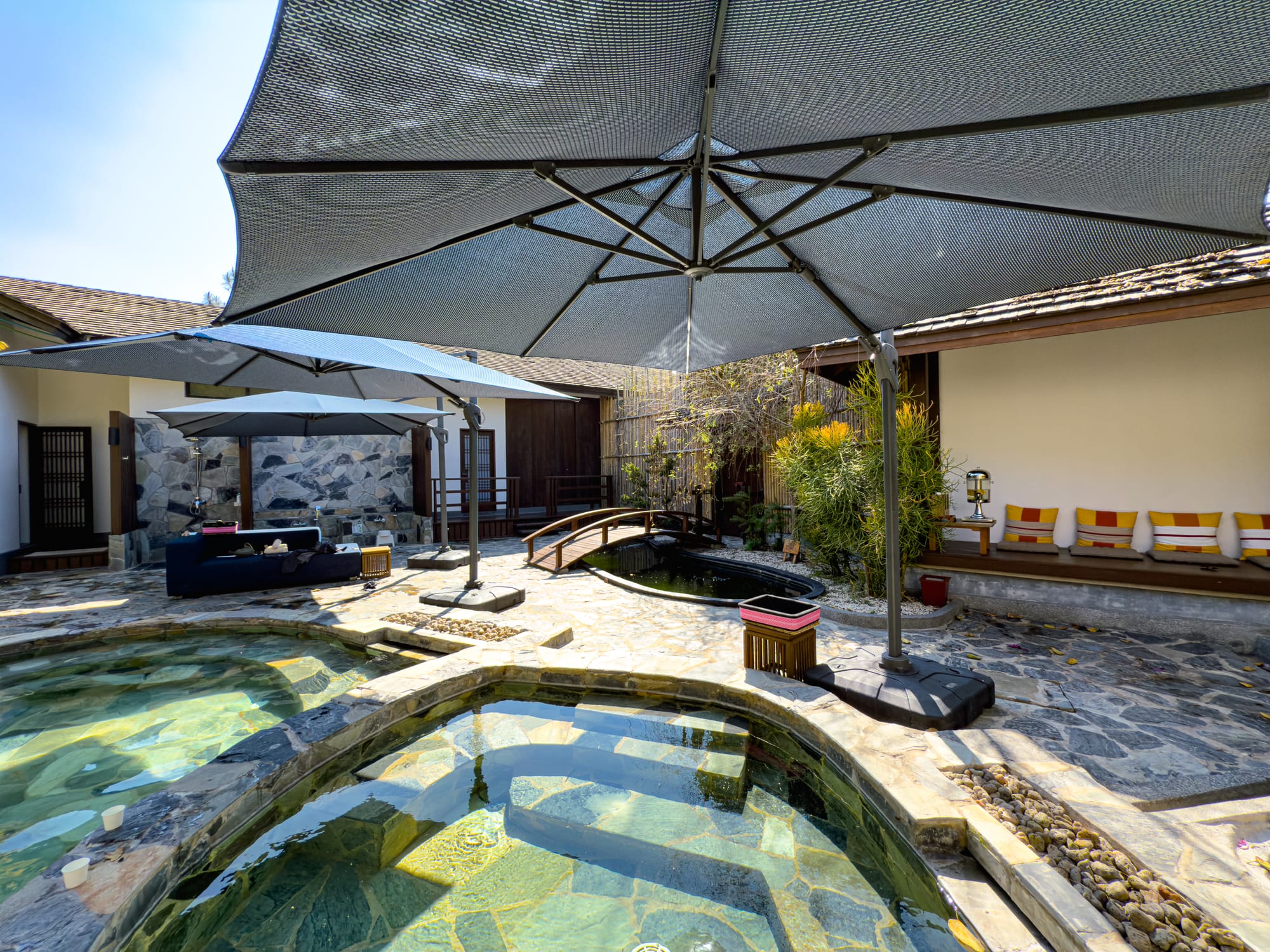
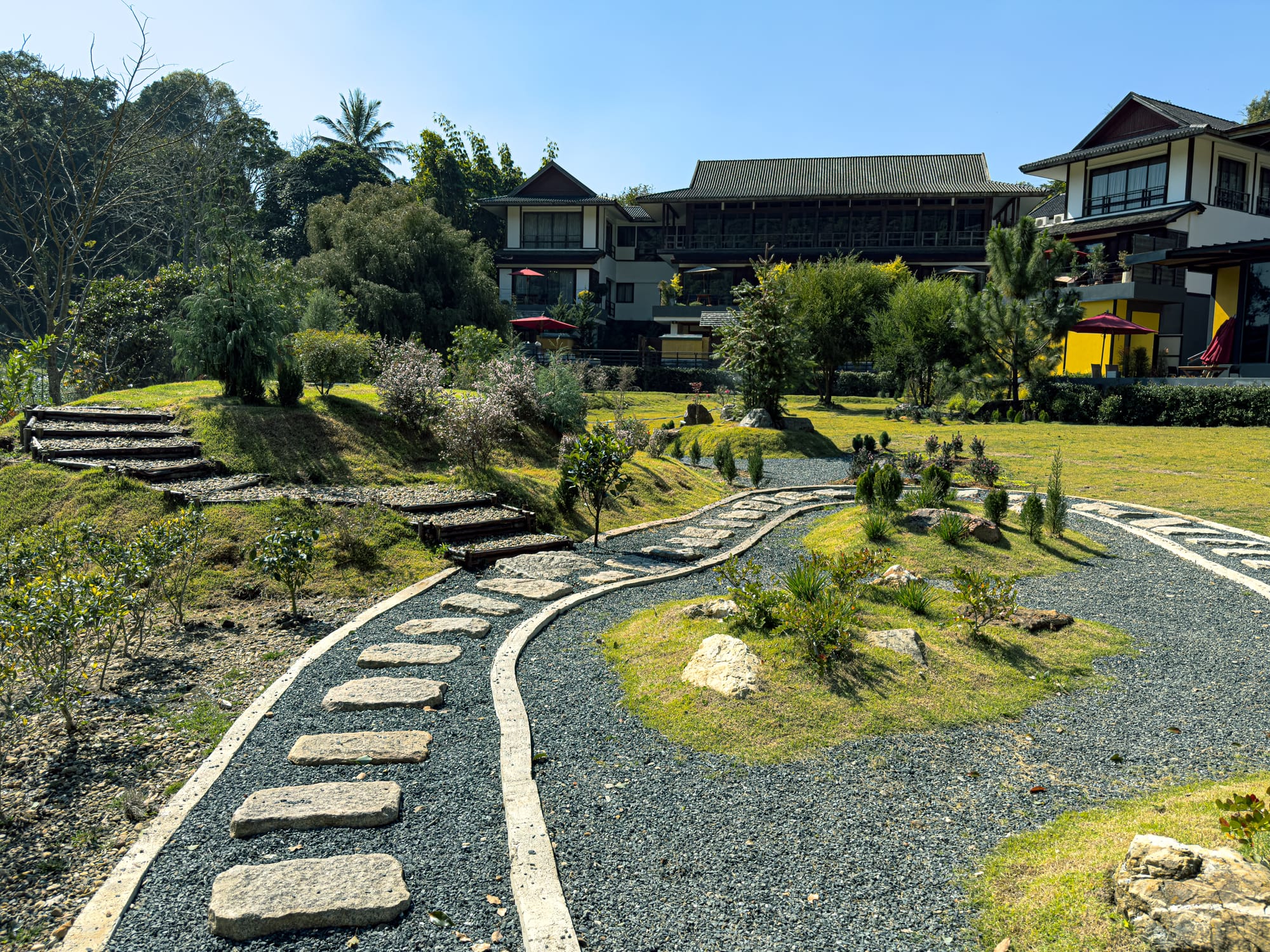
You can book a day pass for shared access or splurge on a private garden onsen, where hot and cold baths are yours alone for an hour or two. Between the architecture, the citrus-scented water, and the tranquil setting, it’s one of Chiang Mai’s most unique spa experiences—a little slice of Japan in northern Thailand.
Tok Sen massage
A northern Thai massage technique using rhythmic wooden tapping.
Unique to Chiang Mai and northern Thailand, Tok Sen is a centuries-old massage style that uses a wooden hammer and chisel to gently tap along the body’s energy lines. The vibration penetrates deep into the muscles, creating a release that feels different from any other massage technique—more resonant than pressing, more soothing than pounding.
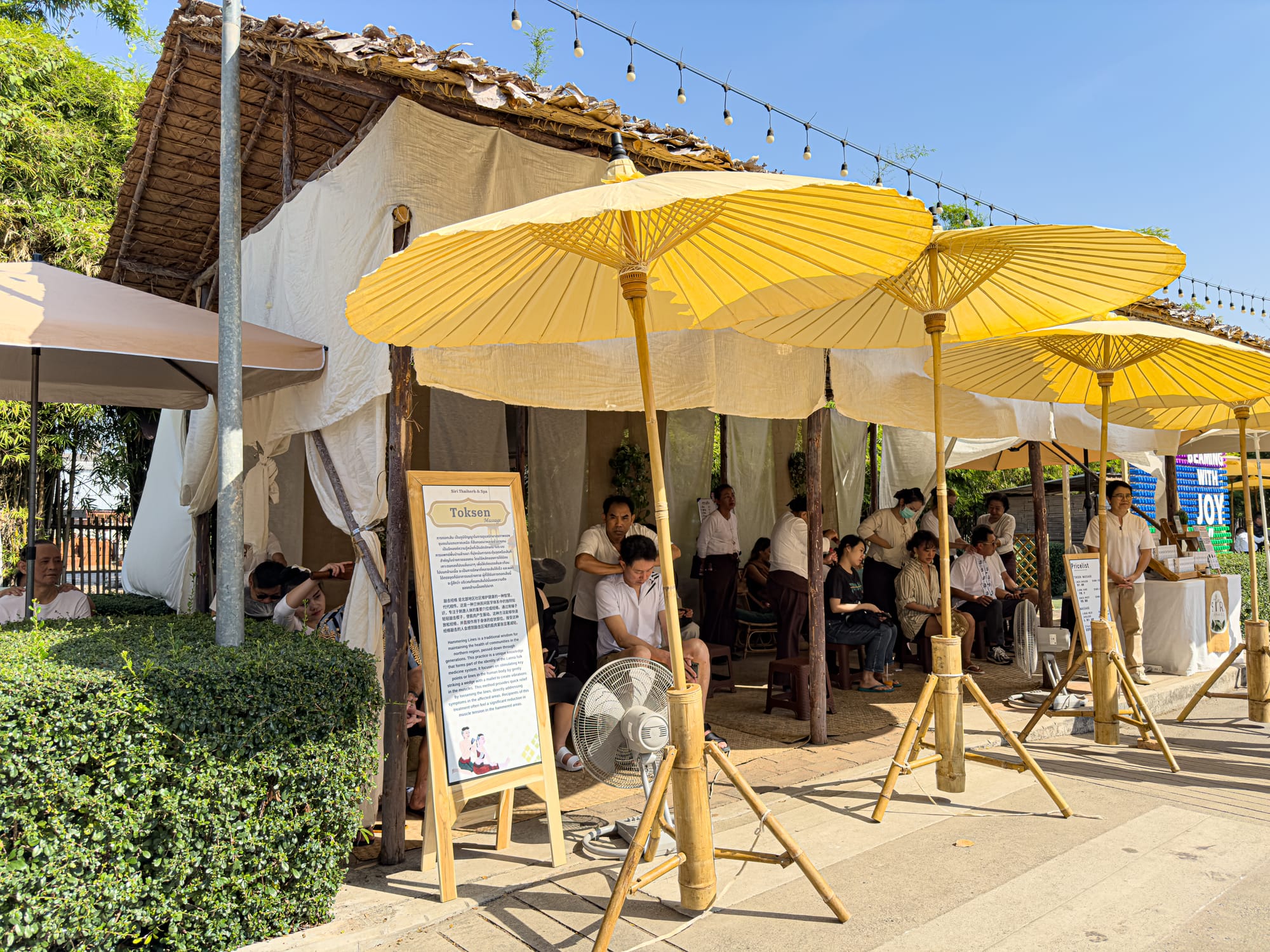
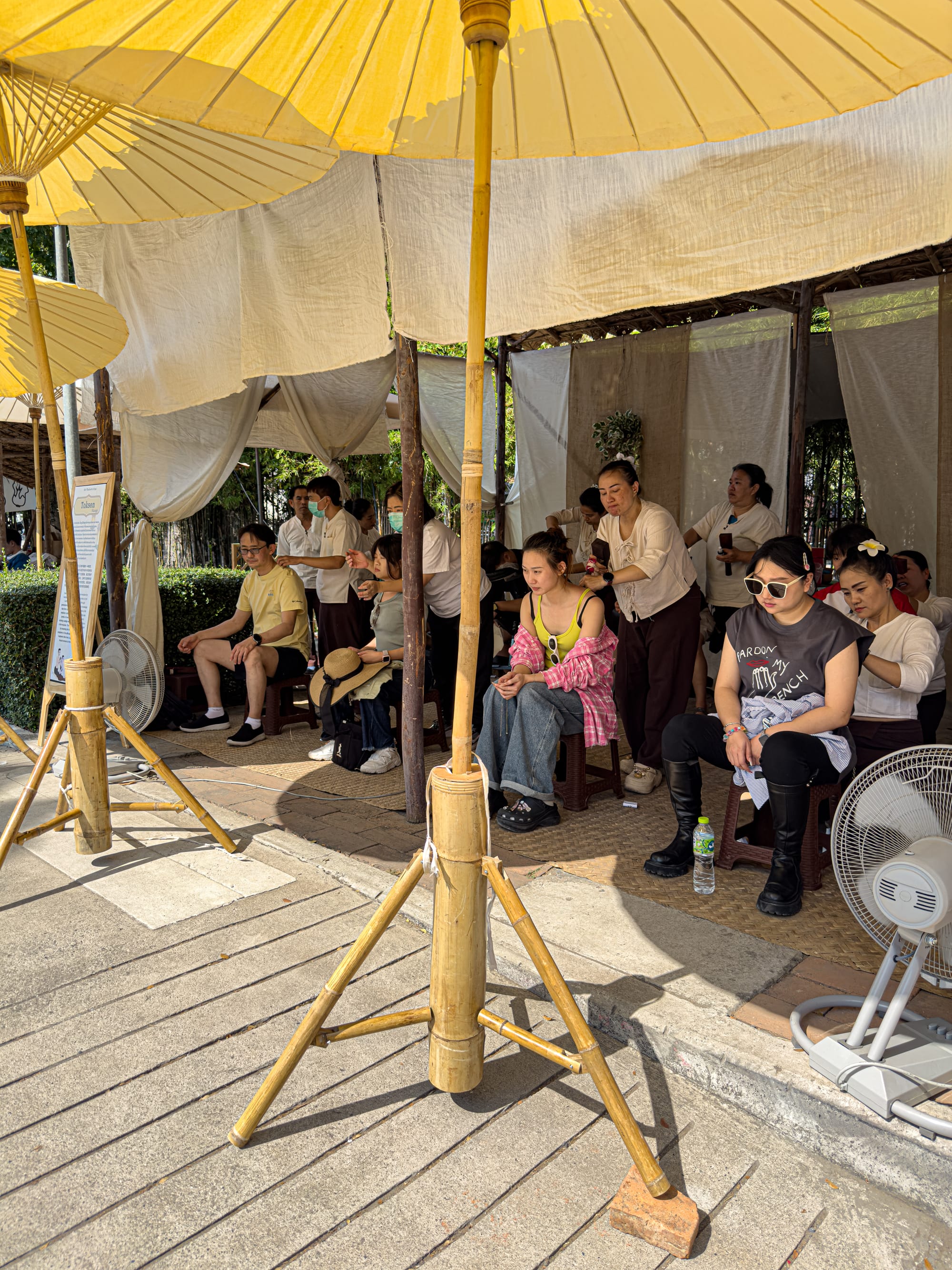
Many local spas and massage schools in Chiang Mai offer Tok Sen, often alongside traditional Thai massage. It’s both therapeutic and cultural, giving you a chance to experience a practice passed down through generations of Lanna healers. For those curious about the region’s wellness traditions, this is one not to miss.
Markets and craft villages
Baan Kang Wat creative village
An artsy courtyard market west of the Old City.
West of the Old City, Baan Kang Wat is one of Chiang Mai’s most unique markets—a leafy, art-focused village where local makers and small studios open their doors. Instead of crowded stalls, you’ll find wooden houses and open-air workshops, each offering ceramics, textiles, handmade journals, soaps, and other crafts made with care. The atmosphere is slow and creative, more like an open-air gallery than a typical market.
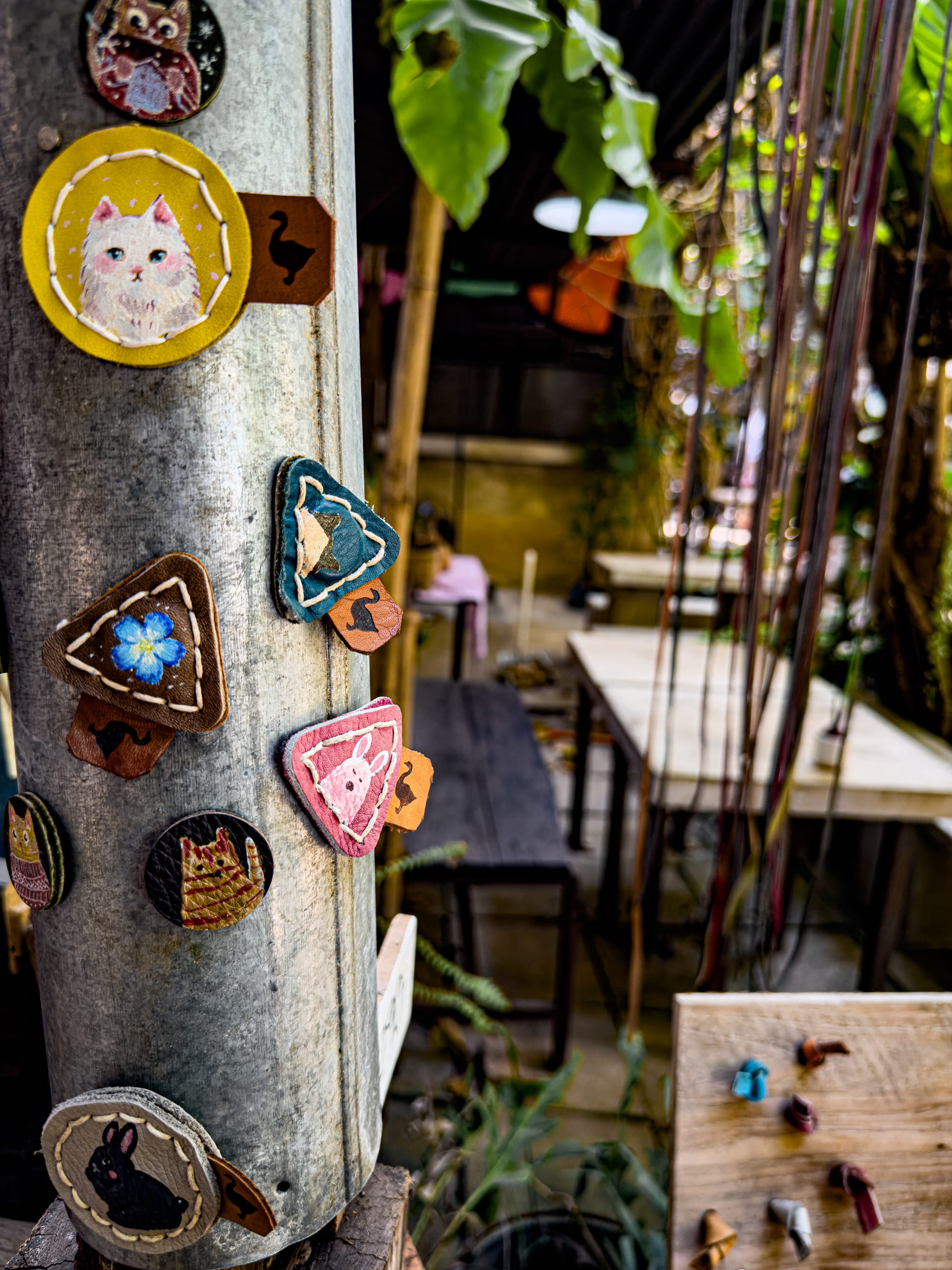
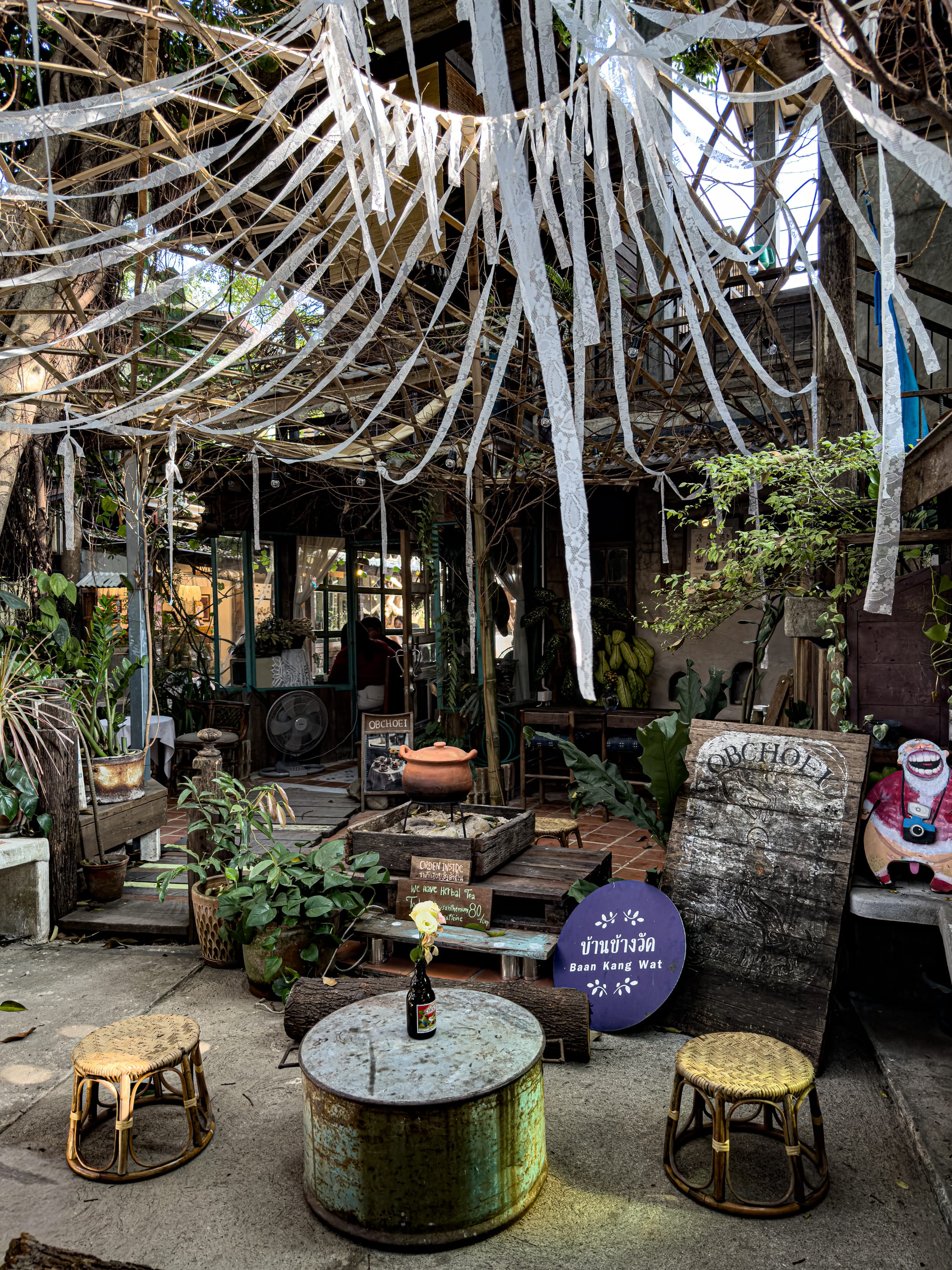
Cafés and small eateries are woven into the courtyard, making it easy to linger over coffee or a plant-based dish while you browse. On weekends, community events and workshops bring the space to life, with visitors often trying their hand at crafts or simply soaking up the laid-back, artistic vibe. It’s a refreshing alternative to Chiang Mai’s busier markets and a favorite spot for those who value creativity and calm.
Jing Jai Market
A weekend market north of the Old City.
Every Saturday and Sunday, Jing Jai Market transforms into one of Chiang Mai’s liveliest yet most relaxed community gatherings. Shaded beneath tall trees, rows of stalls showcase organic produce, handmade crafts, and local street food. Farmers bring in fresh vegetables and fruit, while artisans sell soaps, textiles, and eco-conscious products. The vibe is calm and family-friendly, making it a refreshing contrast to the more hectic night bazaars.
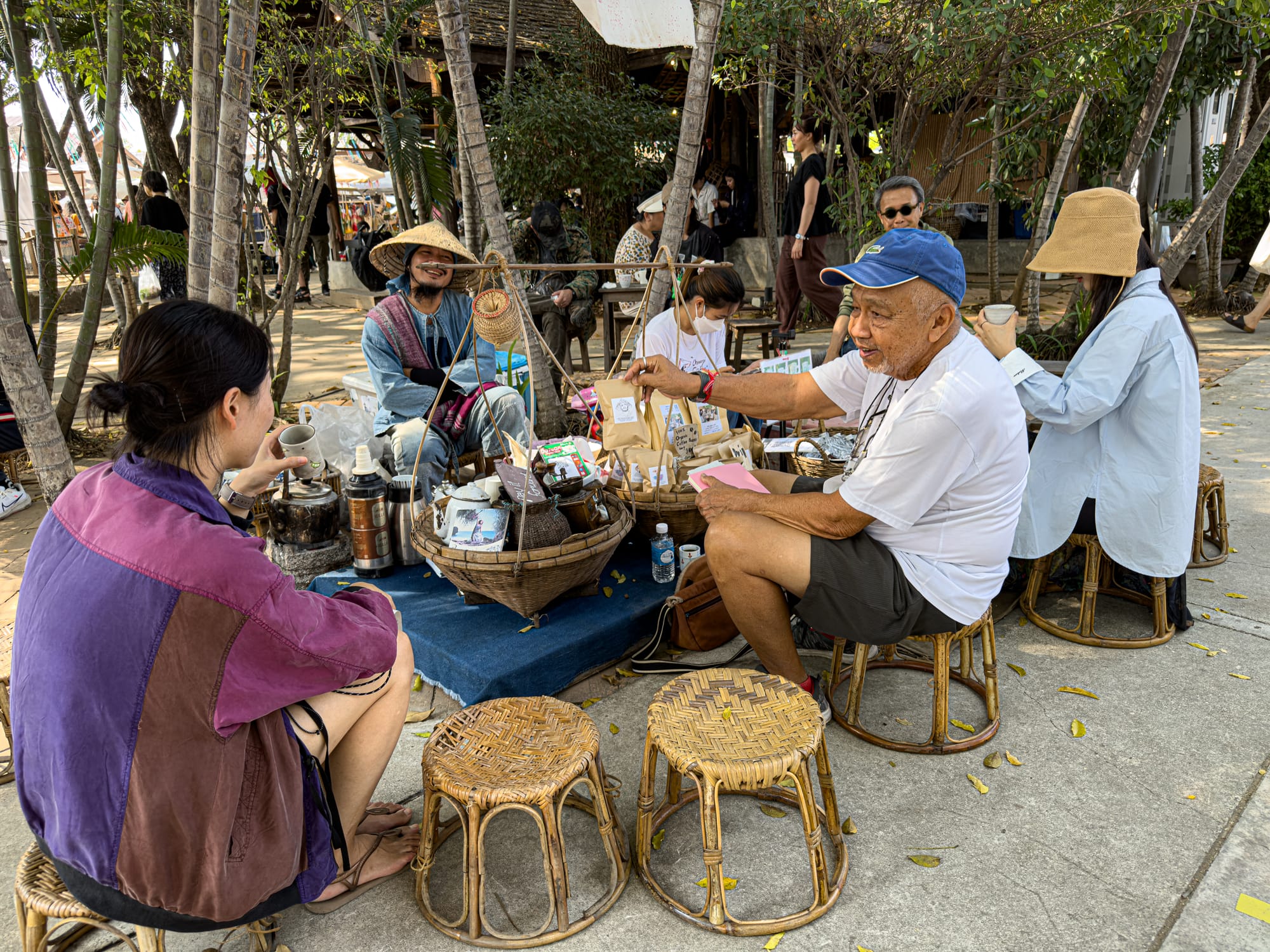
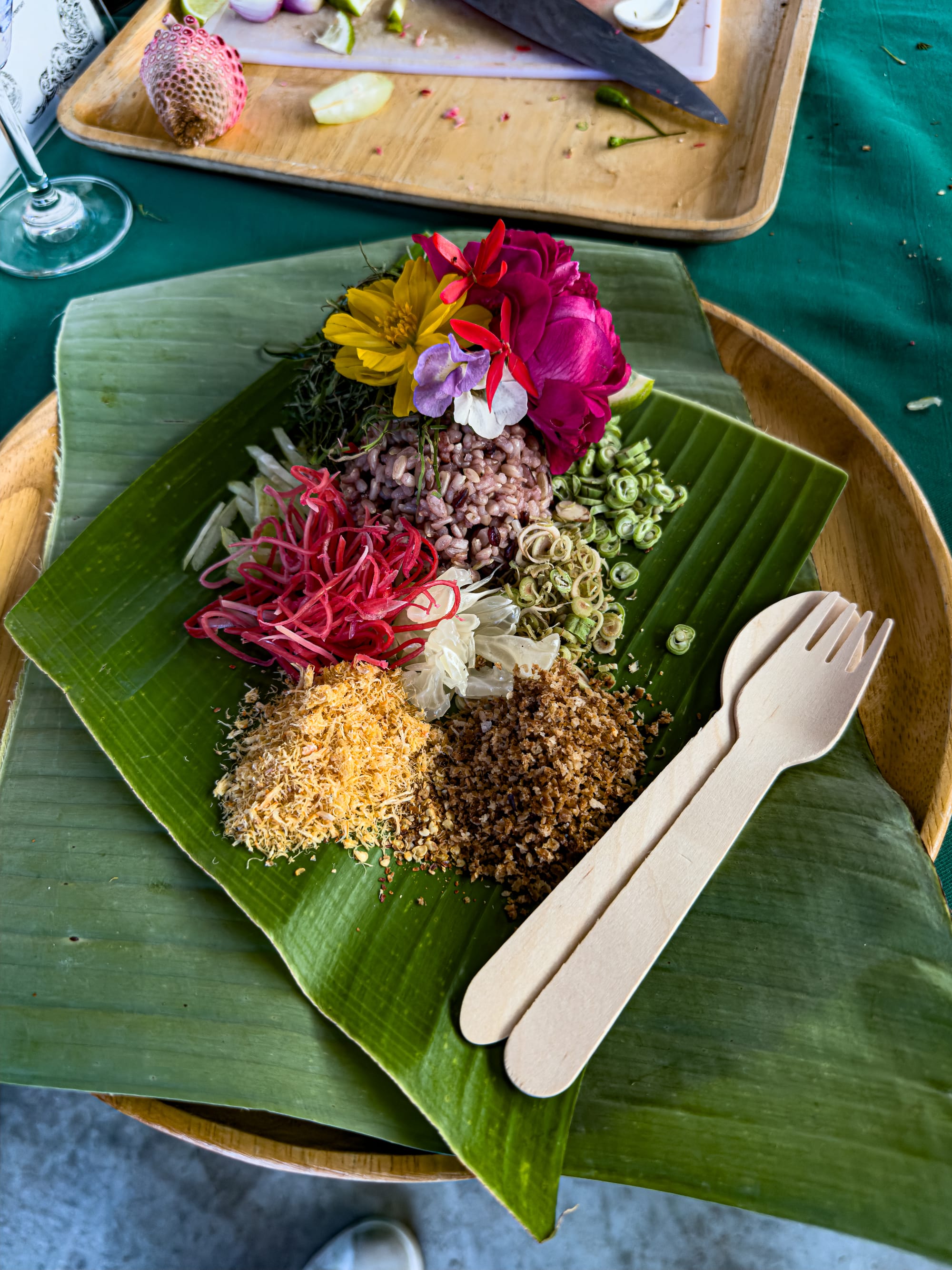
Food is a big draw here—think vegan snacks, tropical smoothies, fresh fruit, and plant-based treats that make it easy to eat well while you explore. Alongside the food, the market’s emphasis on sustainability and local goods gives it a distinct personality. Whether you’re shopping for handmade souvenirs or just people-watching over a coffee, Jing Jai Market offers a weekend ritual that feels both local and creative.
Bamboo Saturday Market
A small, nature-framed market with a local feel.
Held every Saturday morning northwest of the Old City, Bamboo Market is smaller and calmer than most of Chiang Mai’s other markets. Nestled in a leafy setting, it has a distinctly local vibe, with farmers, gardeners, and artisans setting up simple stalls. You’ll find fresh vegetables, herbs, flowers, and homemade goods alongside hot breakfasts cooked on-site. The slower pace and natural surroundings make it feel more like a neighborhood gathering than a tourist attraction.
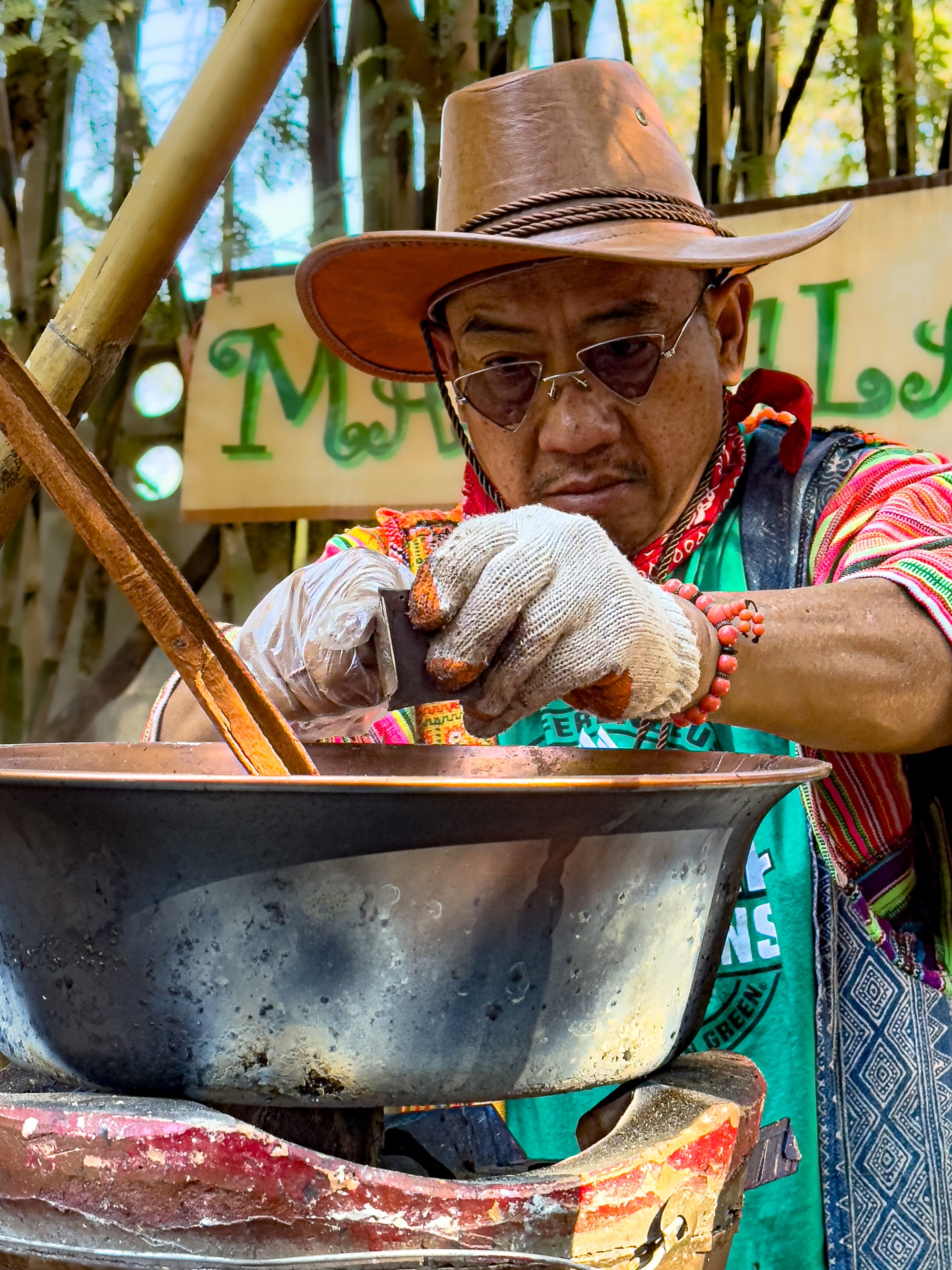
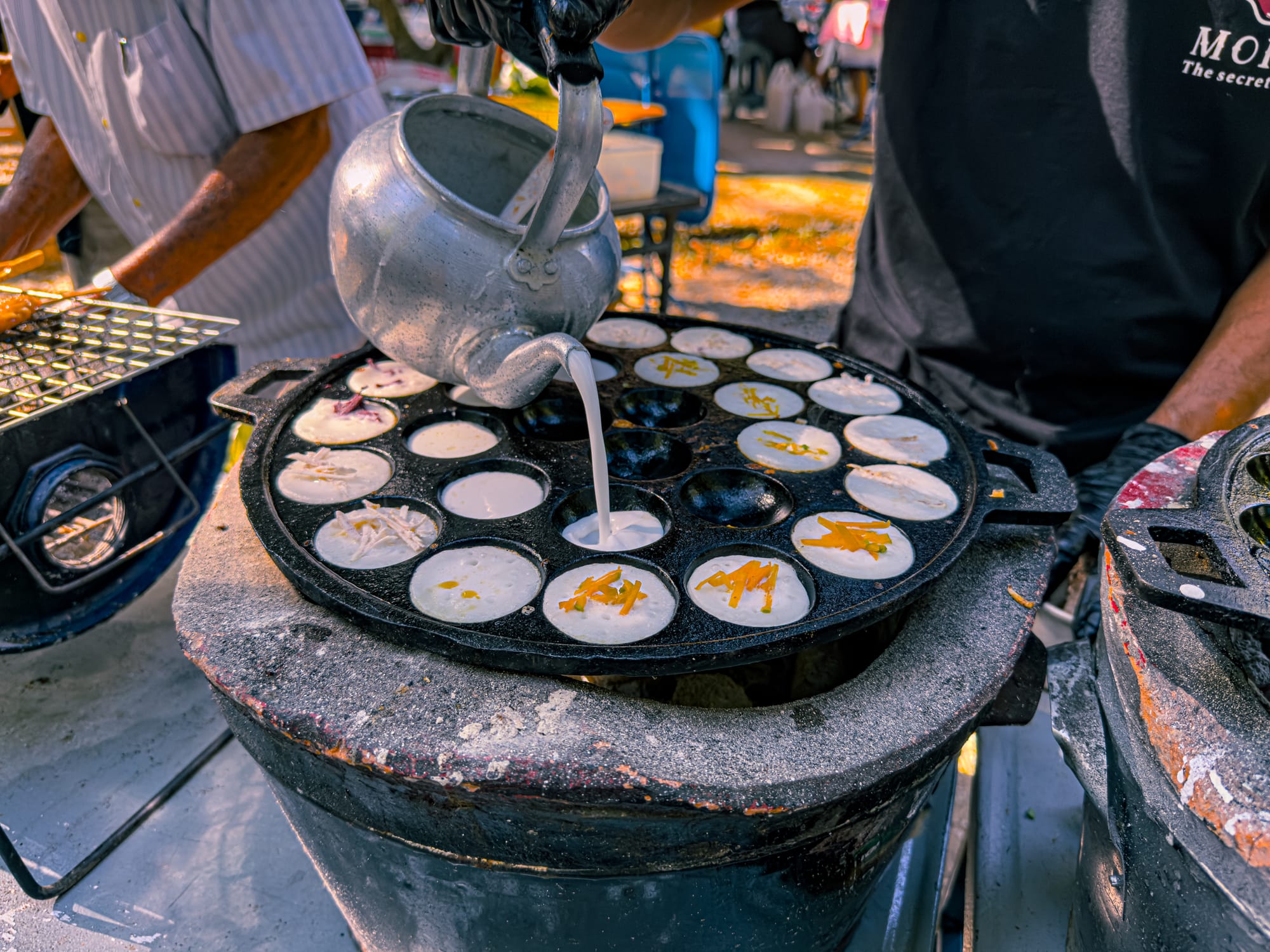
One highlight is the cacao stall, where a vendor prepares rich, aromatic cacao drinks that warm you for the day. You’ll also see handmade soaps, jams, and other small crafts, each reflecting the care and creativity of the community.
Mueang Mai Market
Chiang Mai’s bustling wholesale produce hub.
Located near the Ping River, Mueang Mai Market is where many of the city’s restaurants source their fruit, vegetables, herbs, and spices. It’s sprawling, lively, and less curated than weekend markets, with rows of stalls piled high with everything from tropical fruit to fresh greens and sacks of chilies. The atmosphere is busy and unpolished—part of its charm—offering a glimpse into the everyday rhythm of local trade.
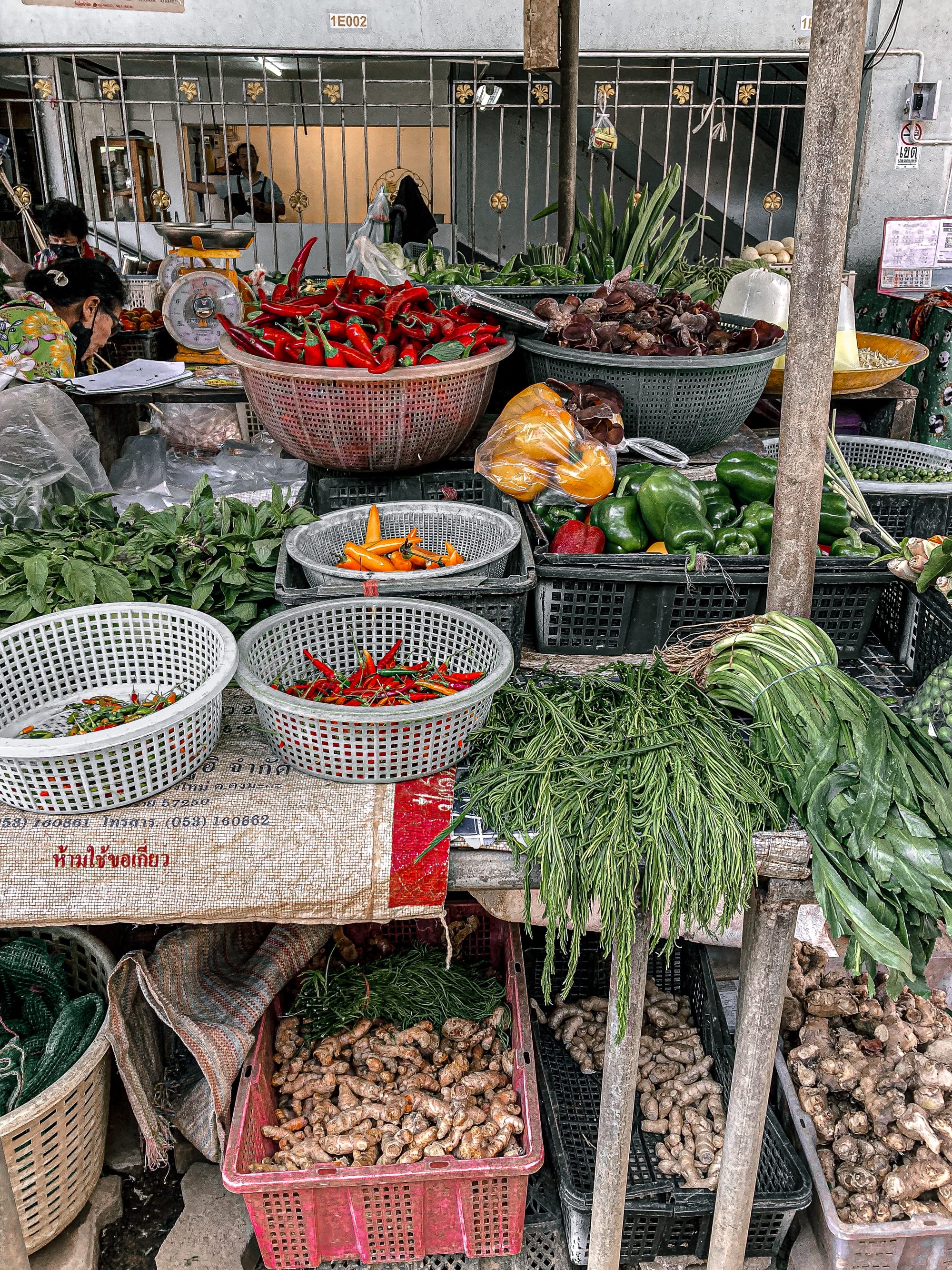
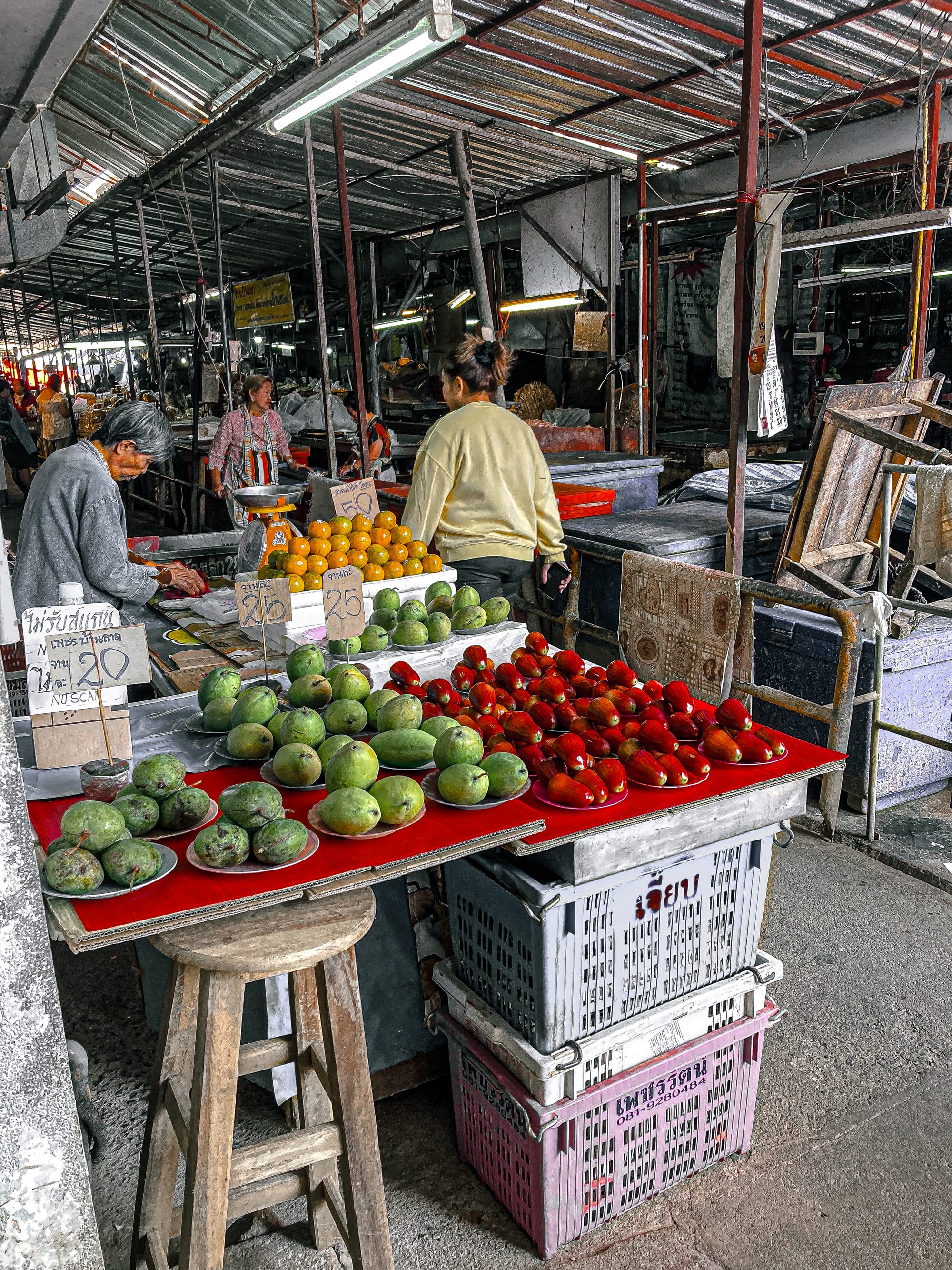
For visitors, it’s an atmospheric place to wander, camera or basket in hand. You’ll see restaurant buyers loading trucks, vendors calling out deals, and piles of produce stacked almost artfully. It’s not the easiest market to navigate, but if you want to feel plugged into Chiang Mai’s food supply chain, Mueang Mai is the spot.
Essential tools for Chiang Mai
For nomads living and working from Chiang Mai, these tools made our stay smoother.
Saily Global eSIM
Instant global mobile data without needing a local SIM. Saily global eSIM gives you mobile data in Thailand and dozens of other countries—no need to buy a separate local SIM when you arrive. Great for digital nomads who hop between places and want one seamless solution that works everywhere.
SafetyWing (global health & travel insurance)
An affordable, digital-nomad-friendly insurance plan that covers both travel hiccups and medical needs. We like that it runs month-to-month and can be started even if you’re already abroad. Helpful for peace of mind, especially on remote islands where care may require transfers or added costs.
NordVPN
A lightweight, fast VPN that lets you secure your connection on public wifi—especially important when working from colivings, cafes, or airports. It also lets you access content as if you were back home, which is helpful for banking, streaming, or logging into sensitive accounts.
Wise (multi-currency payments)
Our favorite banking solution for multi-currency payments and avoiding bad exchange rates. Wise lets you pay in Thai baht locally and manage funds across dozens of currencies. We used it to split group dinners, pay for tours, and withdraw cash without the large fees traditional banks charge.
Should you choose Chiang Mai?
Chiang Mai is one of the most established digital nomad hubs in the world—and for good reason. The city combines deep cultural texture with modern convenience, an endless café and coworking scene, and one of the largest nomad communities anywhere. Whether you’re coming for a season or longer, it’s the kind of place where you can find your rhythm quickly.
The pros?
- A massive, diverse digital nomad community—you’ll meet people instantly and find groups that match your interests
- Dozens of coworking spaces and cafés designed for laptop work
- Strong coliving scene, from Alt_ChiangMai to The Social Club and Hub53
- Excellent vegan food culture, plus affordable local eats and lively markets
- Easy access to nature—mountains, waterfalls, hot springs, and weekend getaways in Mae Rim or Pai
- Affordable cost of living compared to Western cities
- Rich cultural atmosphere with temples, festivals, and creative energy
The trade-offs?
- Burning season (roughly February–April) brings poor air quality that many nomads choose to avoid
- Summers can be uncomfortably hot, especially June–August
- Being around so many nomads can make it harder to connect with local people and culture
Chiang Mai is for those who want abundance. If you thrive in an environment where community, culture, food, and work-friendly spaces are everywhere you turn, it’s one of the best places in Southeast Asia to base yourself.
Read more
If you’re curious about how to make Chiang Mai work for you, we’ve written extensively about our experience. Check out our Chiang Mai guides for more information on what we enjoyed in the region.






